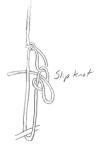Here are the guidelines for the notes sheet that you can use on the exam:
There are 25 multiple choice questions and about 15 problems.
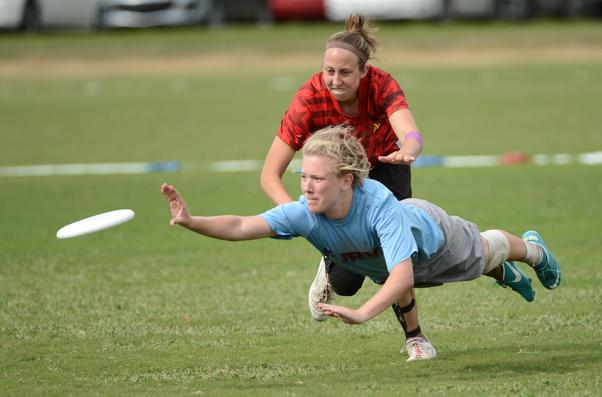 Warm-Up
:
Warm-Up
:
1. How does a "Frisbee" work?
2. Why is "Frisbee" in quotation marks?
3. Typical sport discs tend to roll over in the air. For a right hander throwing a forehand, does the disc tend to roll to the thrower's right or to the thrower's left?
4. What are two solutions to the problem described in #3, above?
5. One explanation which has been offered to explain the direction of the roll is uneven lift between the front and the back of the disc. If this is the case, where do you suppose the stronger lift would be found, at the front or at the back of the disc?
Today:
- Optics quiz
- Questions about the exam?
- Hang out in the room? Ultimate?
-
Scan of solutions (except for optics) Scan of optics solutions.
Homework:
- Exam preparation
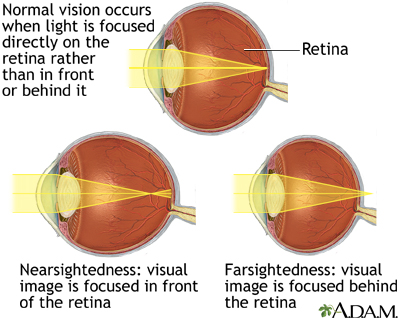 Class
80.5
Friday 6/8/17
Class
80.5
Friday 6/8/17Warm-Up :
1. Why can't humans see clearly under water?
2. Guess which condition (on the right) makes it easier to see clearly under water?
3. Goggles and masks can be used to see clearly under water, but they distort the observed heights of objects. Do they magnify or reduce? Why?

Today:
- Optics quiz -- today or Monday
-
Scan of solutions (except for optics) Scan of optics solutions.
Homework:
- Exam preparation
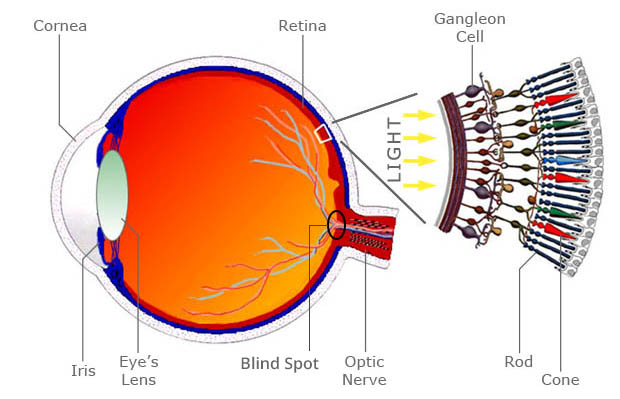 Class
80
Thursday 6/8/17
Class
80
Thursday 6/8/17Warm-Up :
1. What would you guess is the approximate focal length of the human eye?
2. Does that focal length change? Explain.
3. Why do we have a blind spot?
4. How can you "find" your blind spot?
5. How does a pinhole camera work?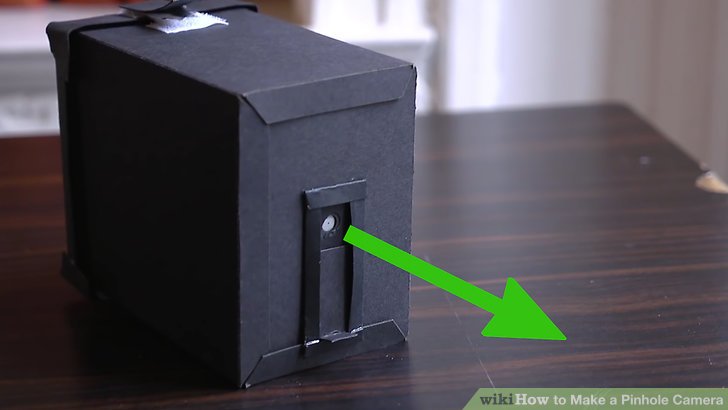
6. Regarding the lower diagram on the right, why is it necessary
for the rays to cross in order to form an image?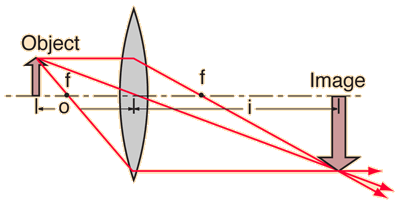
Today:
-
Cross out optics questions 6-8 on the exam review. Instead, there will be one optics problem like #1, #4a, of #4b, from Practice: 25.6, part 2 Solutions.
-
Go over the homework. Prepare for the optics quiz (or optics portion of the final).
-
Scan of solutions (except for optics) Scan of optics solutions.
Reading: Chapter 25.6 -- Image formation by lenses
Homework:
- If you're exempt from the exam, prepare to take the optics quiz tomorrow or on Monday.
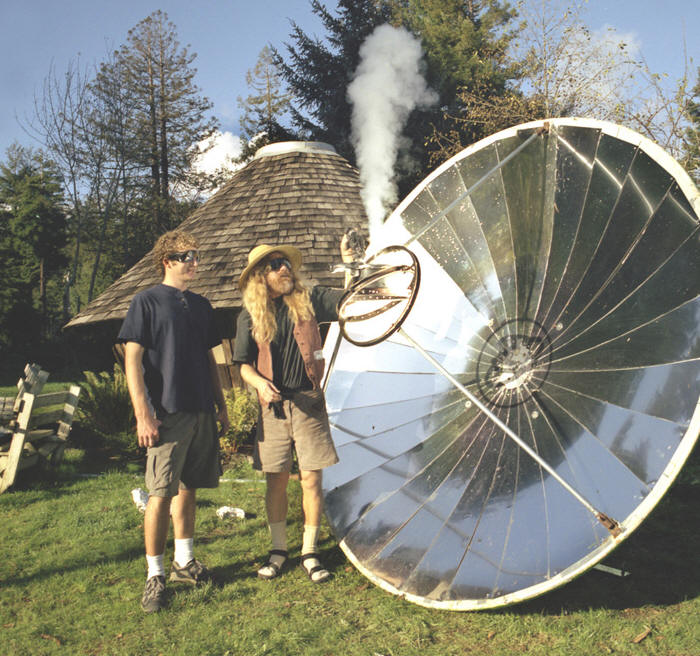 Class
79.5
Wednesday 6/7/17
Class
79.5
Wednesday 6/7/17Warm-Up :
1. What is the shape of this solar cooking dish?
2. Why is this the best shape for this type of solar cooker?
Today:
-
We will go over the homework tomorrow.
-
Find focal lengths of convex lenses
-
Find the focal length of a parabolic mirror
-
Make a cone of smoke?
-
Form a focused image with a convex lens
Reading: Chapter 25.6 -- Image formation by lenses
Homework:
- If you haven't doe this already... Practice: 25.6, part 2 Solutions
Warm-Up :

2. What are RGB and CMYK color models? What's the difference?
Today:
-
Add this formula to the exam formula list

-
Work time -- homework, review, instrument slideshow, make-up work
Reading: Chapter 25.6 -- Image formation by lenses
Homework:
Warm-Up :
Fred is conducting a laser experiment on a very, very, very fast train. He attaches a mirror to the roof of the train car and shines a quick pulse of laser light directly upward at the mirror. Hank is standing still outside the train. The train car is made of glass, so Hank can see the whole thing.
The pulse of laser light goes up, reflects off of the mirror, and then goes back down to the floor. There's enough dust in the air to make the laser pulse visible.
1) If Fred and Hank were to draw the laser's "flight path" (as each of them sees it), what would each of them draw?
2) Who would see light travel a greater distance?
3) Assuming that Hank and Fred see light traveling the same speed, who sees it travel for the longest amount of time?

Today:
-
Check/discuss homework. Solutions 25.5. Solutions 25.6.
-
I will not be checking any more homework. If you want to know if you're exempt from the exam, be sure to submit your instrument slideshow ASAP.
-
Exam Review. I hope to provide a more convenient list, plus solutions, soon.
-
Optics quiz on Friday (or Monday) for exempt seniors. The quiz will cover chapter notes and practices 25.1-25.6, including the notes and practice from tomorrow's class (25.6, part 2 Notes Practice Solutions).
Reading:
Homework:
- Instrument Slideshow due Tomorrow. string instrument slideshow directions and grading Link to Instrument Project Submission Form
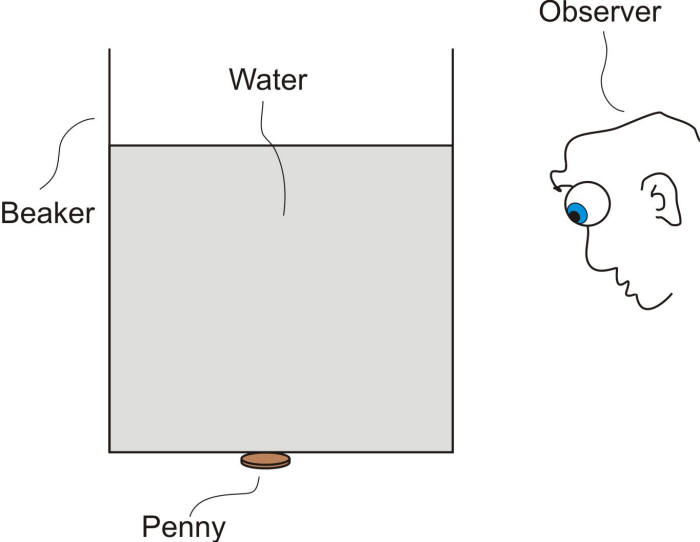 Class
78
Thursday 6/2/17
Class
78
Thursday 6/2/17Warm-Up :
The ability of the observer on the right to see the penny depends on whether the penny is wet or dry.
1. When can he see the penny?
2. Explain why.
Today:
-
Adam test score?
-
Return papers. Discuss homework. Solutions
-
Notes: Ch 25.5-25.6
-
After today, we have three full classes and three short classes of physics.
-
Final exam review packet on Monday.
-
Is anyone (non-exempt) planning on being absent on the final exam day?
-
Optics test: Non-Exempt Students -- optics will be part of the final exam. Exempt Seniors -- optics test will be separate and taken on the last day of class (Monday, 6/12). Corrections may be completed during exam week.
-
Create Instrument Recordings. Do not count on class time to work on this on Monday. string instrument slideshow directions and grading Example
Reading:
Homework:
- Practice 25.5-25.6. Solutions 25.5. Solutions 25.6.
- Instrument Slideshow due on Tuesday. string instrument slideshow directions and grading Link to Instrument Project Submission Form
 Class
77.5
Thursday 6/1/17
Class
77.5
Thursday 6/1/17Warm-Up :
1) What are major and minor scales?
2) How are they played on a piano? What about a fretted string instrument?
Today:
-
Return tests
-
Turn-in Homework (odd numbers only in Practice 25.3/25.4)
-
Create Instrument Recordings. string instrument grading Example
Reading:
Homework:
- Work on instrument recordings. string instrument grading
Warm-Up : No warm up today
Today:
-
Bonus point Doppler challenge
-
Test
Reading:
Homework:
- In case you haven't already done this... complete the odd numbers only in Practice 25.3/25.4. Solutions
- Have your instrument ready to make recordings tomorrow.
Warm-Up :
primary and secondary rainbows
4. What is the connection between these pictures and refraction?


Today:
-
Test tomorrow. 4 Minute Drill. Questions?
-
Check/review homework and laser activity
-
Homework (odds only) Solutions
-
Laser activity
-
-
Instrument recordings and analysis will have to happen on Thursday. Preview of recording process.
Reading:
Homework:
- Test tomorrow over sound/waves notes, all homework practice problems, and the material on the practice test. Optics will not be on the test. Material corresponds roughly to Chapter sections 16.9, 16.10, 17.1, 17.3, 17.4, and 17.5. Mr. Pennington's test review sheet from last year (modified slightly). Bonus points may be earned by using your instrument to determine the velocities of passing vehicles.
- Have your instrument ready to make recordings on Thursday. To understand what completed means, see the string instrument grading criteria.
Warm-Up :
It is a common experience for words viewed in a mirror to appear to have been flipped. Suppose you look in a mirror while wearing a shirt that says "shirt."
1. Which shirt shows what you will see?
2. Why does the word get flipped that way, and not the other way?

Today:
-
Check/review homework
-
Conceptual Practice: Reflection and Refraction With Laser Boxes
Reading:
Homework:
- Complete the odd numbers only in Practice 25.3/25.4. Solutions
- Test on Wednesday over sound/waves notes, practice test, and today's SHM notes. Material corresponds roughly to Chapter sections 16.9, 16.10, 17.1, 17.3, 17.4, and 17.5.
- Instruments must be completed before class on Tuesday. To understand what completed means, see the string instrument grading criteria.
Warm-Up :
The diagram below shows top views of the same boy looking into mirrors. On the right, the mirror is a simple flat mirror. On the left, the mirror is two separate mirrors arranged at right angles. The boy has one blue eye and one green eye.
When he looks in the mirrors, where will his blue eye appear to be?
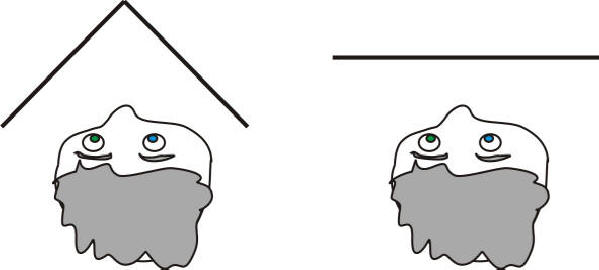
Today:
-
Check/review homework
-
Begin Geometric Optics (not physical optics or quantum optics)
-
Practice
Reading:
Homework:
- Practice 25.1-25.2 Solutions
- Test on Wednesday over sound/waves notes, practice test, and today's SHM notes. Material corresponds roughly to Chapter sections 16.9, 16.10, 17.1, 17.3, 17.4, and 17.5.
- Instruments must be completed before class on Tuesday. To understand what completed means, see the string instrument grading criteria.
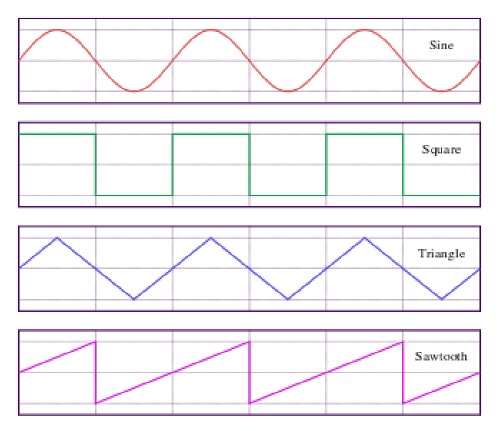 Class
75
Wednesday 5/24/17
Class
75
Wednesday 5/24/17Warm-Up :
These are transverse representations of longitudinal sound waves.
1. What does the statement above mean?
2. How are the waves similar?
3. How are they different?
4. What do they sound like? link won't work on school wifi
5. What would a cosine wave look like?
Today:
-
Simple Harmonic Motion:
-
Test on Wednesday
-
Today is the last in-class instrument construction day (what constitutes a finished instrument?). After today, I will keep tools in my flex block (C211). You may also take your instrument home to work on it.
-
On Tuesday, you will begin making recordings. The final project will not be due until the following Monday, June 5th.
Reading:
Homework:
- Finish the back of Notes: Simple Harmonic Motion (SHM) Solutions
- Test on Wednesday over sound/waves notes, practice test, and today's SHM notes. Material corresponds roughly to Chapter sections 16.9, 16.10, 17.1, 17.3, 17.4, and 17.5.
- Instruments must be completed before class on Tuesday. To understand what completed means, see the string instrument grading criteria.
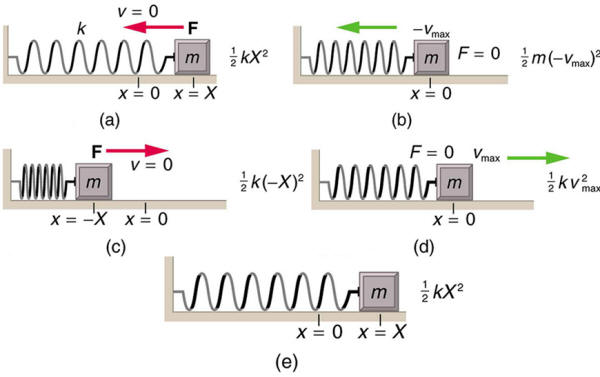 Class
74.5
Tuesday 5/23/17
Class
74.5
Tuesday 5/23/17Warm-Up :
The figures on the right show a mass that is oscillating back and forth in a frictionless situation. What factors determine the rate at which the mass is accelerated by the spring?
Today:
-
Check/discuss practice test
-
Relationship between vibrating strings and simple harmonic motion equations
-
Tomorrow -- finish instruments
Reading:
Homework:
- None
 Class
74
Monday 5/22/17
Class
74
Monday 5/22/17Warm-Up :
1. How does a violin bow cause a string to vibrate at its resonant frequency?2. How does rubbing your finger on the rim of a glass create sound?
3. What steps would one follow to break a glass with one's voice? Would you like to try?
Today:
-
No instrument work today.
-
Return Tests
-
Check/discuss the last two homeworks
-
17.4 Practice solutions
-
Answers to B and C, on the recent homework (Hopefully I am remembering correctly): 86.4m/s, 29.4m/s
-
-
Doppler Effect Videos and Simulations
-
Skip Matching #2 and Problem #8, part D on Practice Test
Reading:
Homework:
- Skip Matching #2 and Problem #8, part D on Practice Test Solutions
 Class
73.5
Friday 5/19/17
Class
73.5
Friday 5/19/17Warm-Up :
How can we use a piano to measure something's speed?
Today:
-
Return Tests
-
Intro to the homework
-
Finish string instruments
-
Tune
-
Clean up your mess.
-
Be safe.
-
-
Begin homework.
Links:
Reading:
Homework:
- Complete Measuring Speeds Using a Piano. Listen to these changes in pitch. Pretend that the changes in pitch represent a Doppler shift for a moving vehicle. Using this Virtual Piano or some other instrument, try to determine the number of half steps by which the pitches changed. Contrary to how intervals are named in the context of music, count only the half steps that represent change. Do not count the beginning and ending notes.
 Class
73
Thursday 5/18/17
Class
73
Thursday 5/18/17Warm-Up :
If you're standing next to a race track, what do you hear as the cars pass you?
a. Their pitch changes from high to low.
b. Their pitch changes from low to high.
c. There is no change in pitch.
Today:
-
Return Tests
-
Intro to the homework
-
Finish string instruments
-
Tune
-
Clean up your mess.
-
Be safe.
-
-
Begin homework.
Links:
Reading:
Homework:
- Read section 17.4. Complete the 17.4 Practice. Check your answers and look at the solutions when necessary.
Warm-Up : No warm-up today. Website down. Work on instruments.
Today:
-
Return Tests
-
Build string instruments
-
Clean up your mess.
-
Return tools to their proper locations.
-
Think before you cut or glue.
-
Keep track of your stuff.
-
Stay off of your phone.
-
Be safe.
-
-
Confirm your fret spacing calculations using this spreadsheet
Links:
Reading:
Homework:
Warm-Up : Look over the instrument tools and supplies.
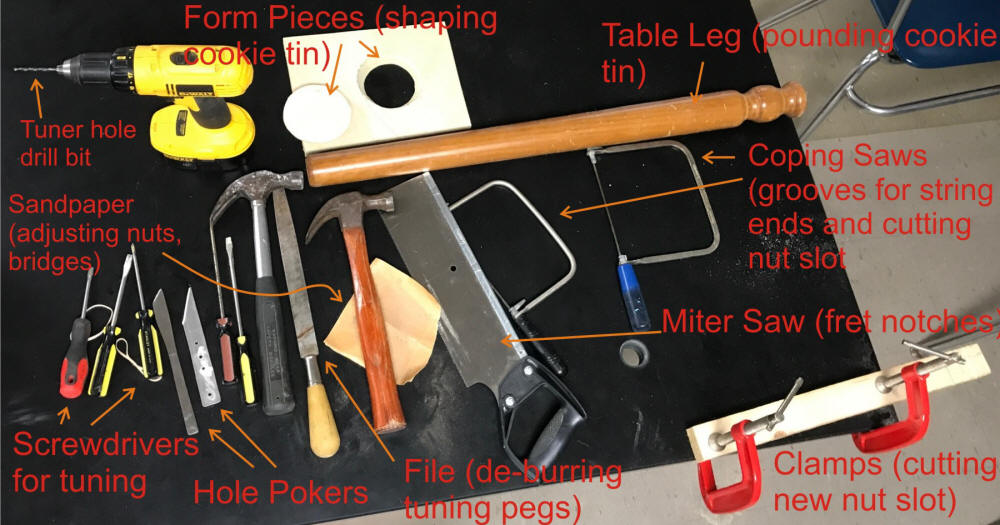
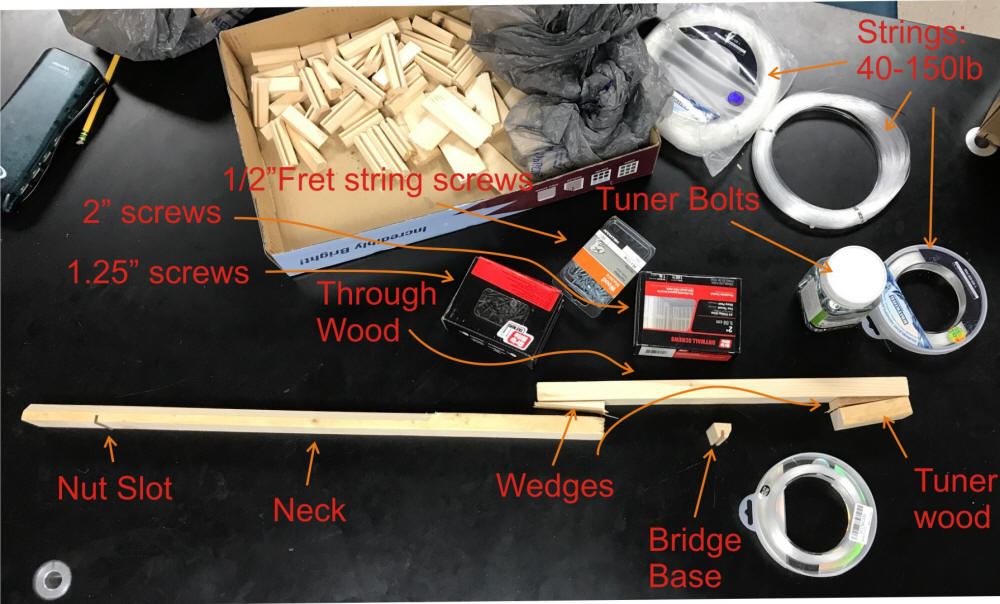
Today:
-
Build string instruments
-
Clean up your mess.
-
Return tools to their proper locations.
-
Think before you cut or glue.
-
Keep track of your stuff.
-
Stay off of your phone.
-
Remain calm.
-
-
Confirm your fret spacing calculations using this spreadsheet
Links:
Reading:
Homework:
- Take a look at Uncle Bob Guitar Project. If you need extra supplies, bring them next class.
 Class
71.5
Friday 5/12/17
Class
71.5
Friday 5/12/17Warm-Up :
1. Identify any nodes and/or antinodes in this video of the "wave pool."
2. Which harmonic is this? Could there be other harmonics?
3. What is the difference between resonance and forced vibrations? Which one applies to the body of an instrument?
Today:
-
Check homework. Questions?
-
Fill out the string instrument supply form (Thank you, Alex and Ethan!).
-
Resonance
Links:
Reading:
Homework:
- Take a look at Uncle Bob Guitar Project. If you need extra supplies, bring them next class.
 Warm-Up
:
Warm-Up
:
As the keyboard shows, there are twelve different notes in western music.
1. Why are there no black keys between B and C (and also E and F)?
2. What is the point of having the black keys?
3. Why are there two rows of keys?
4. What does western mean in this context?
Today:
-
Check homework. Questions?
-
Notes: Standing waves, harmonics, interference, music and string instruments. Filled-In Notes
-
Fill out the string instrument supply form.
-
Links:
-
Transverse Standing Waves simulation
-
Longitudinal Standing Waves simulation
-
Harmonics played on a violin (video)
-
Harmonics played on a flute (video)
Reading:
Homework:
-
Complete
Ch 16.10 and 17.5 practice Plus Fret Calculations Check
your answers. If you cannot get the right answer, look at
these solutions:
- Ch16.1 and 17.5 Solutions.
- Fret calculation Solutions for a ukulele with a 33cm bridge-to-nut distance.
- Make sure that your group fills out the string instrument supply form.
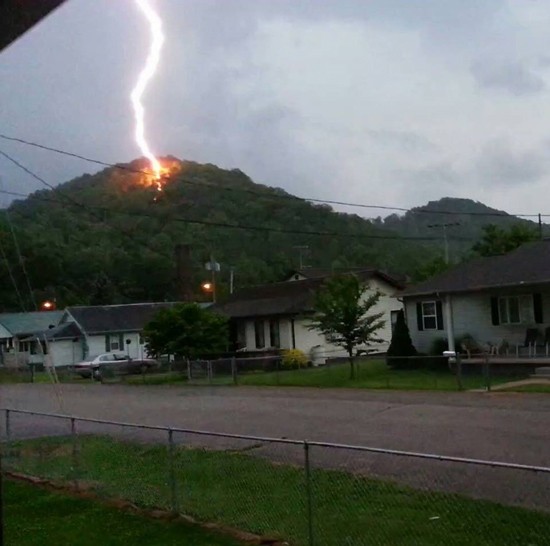 Class
70.5
Wednesday 5/10/17
Class
70.5
Wednesday 5/10/17Warm-Up :
If you see lightning strike a point 1 mile away, how long can you expect to wait before you hear thunder?
Today:
-
Tests are graded. Take a look and return them. I will give them back again on Monday.
-
If anyone brought cookie tins, we will label and store them.
Reading:
Homework:
- 16.9 Practice Solutions
- Browse this website Uncle Bob Guitar Project
 Class
70
Tuesday 5/9/17
Class
70
Tuesday 5/9/17Warm-Up :
Test today. No warm-up. See homework, below.
Today:
-
Test
Reading:
Homework:
- Bring in a cookie tin or some other resonant chamber for creating the body of a string instrument. We're going to make string instruments. Maximum group size = 3.
- You may want to bring in your own wood, strings, pickup, or other materials. I plan to provide pine, fluorocarbon strings, bolts for tuners, and either wire or fluorocarbon for frets.
 Class
69.5
Monday 5/8/17
Class
69.5
Monday 5/8/17Warm-Up :
What's wrong with this cat gif?
Today:
-
Check, go over Kirchoff's Laws #2 Solutions
-
Test tomorrow.
-
Questions?
-
Provided formulas: R = ρL/A V=IR P=VI I=ΔQ/Δt
-
-
Begin Waves and Sound. Waves and Sound Notes Part 1
Reading:
Homework:
- Prepare for test.
 Class
69
Friday 5/5/17
Class
69
Friday 5/5/17Warm-Up :
Use Kirchoff's Rules to write three separate equations for the three labeled currents in the circuit on the right.
Today:
-
Check homeworks:
-
Kirchoff's Laws p1 and p3.
-
Practice test
-
-
Mr. Pennington's test review sheet (doesn't include Kirchoff's Laws)
-
Interesting Link: Electricity FAQs
-
Next Topic: Waves and Sound.
Reading:
Homework:
- In case we don't finish in class -- Kirchoff's Laws #2 Solutions
- Prepare for the test on Tuesday
Warm-Up :
1. If we take a mental trip around loop A, starting and ending at the same point, what is the overall change in potential will we see? What about loop B?
2. What is the numerical relationship between the currrents that meet at each of the junctions?
Today:
-
Check and discuss practice test.
Reading:
Homework:
 Class
68
Wednesday 5/3/17
Class
68
Wednesday 5/3/17Warm-Up :
The graph shows data collected using the same light bulb at a variety of voltages.
1. What does the slope of the curve represent?
2. Why are light bulbs considered to be "non-ohmic?"
3. Why do light bulbs behave in this way?
4. What is a kilowatt-hour? (This will be on the test, but we haven't discussed it much.)
Today:
-
Check/review homework.
-
Wrap-up and go over bulb circuit lab.
-
Optional: Problem #2 of Ch 21 equivalent resistance challenge. See class #67, below, for solutions. If you have questions, see Mr. Stapleton or ask in class.
-
Work on practice test. Before the test, we will work with Kirchoff's rules. There will be at least one problem on the test requiring an application of Kirchoff's rules. Test on Tuesday, 5/9. The test will cover online text sections 20.1-20.4, 21.1, 21.3, and 21.4.
Reading:
Homework:
- Practice Test: Chapter 20-21. Solutions **This practice test does not include Kirchoff's Rules, which will also be on the actual test.
Warm-Up :
No warm-up today
Today:
-
Check/review homework.
-
Work on -- Circuit lab (using multimeters and DC power supplies) -- keep voltages per bulb under 6V.
Reading:
Homework:
- Don't lose the Ch 21 equivalent resistance challenge. We will do #2 later.
- Complete "Circuit Reduction -- The Nine Companions" Check your answers and look at the Solutions if necessary
 Class
67
Monday 5/1/17
Class
67
Monday 5/1/17Warm-Up :
What is the equivalent resistance between points A and B of the circuit on the right?
Today:
-
Return completed homework. Check new homework. Discuss any that were troublesome.
-
Notes and Circuit lab (using multimeters and DC power supplies) -- keep voltages per bulb under 6V.
Reading:
Homework:
 Class
66.5
Friday 4/21/17
Class
66.5
Friday 4/21/17Warm-Up :
Why doesn't a bird on an uninsulated power line get shocked.
Today:
-
Work time. Try to turn in the homework by the end of class today.
Reading:
-
20.4
-
21.1
Homework:
- If you don't finish this today, you can finish it over break... Complete Practice: 20.3, 20.4, and 21.1 20.3Solutions 20.4Solutions 21.1Solutions
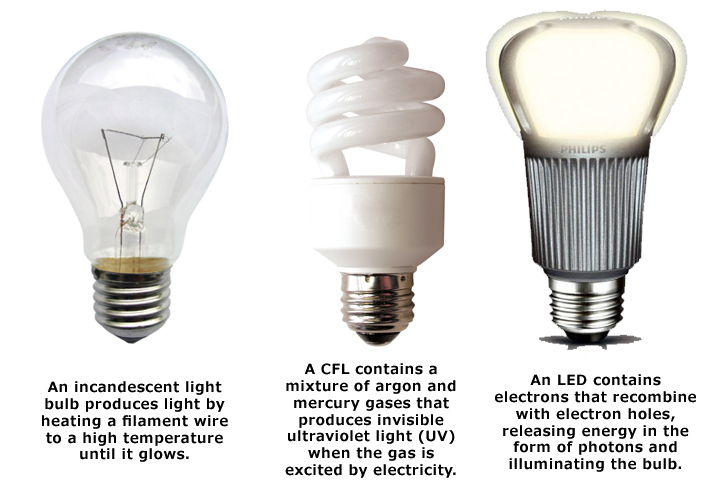 Class
66
Thursday 4/20/17
Class
66
Thursday 4/20/17Warm-Up :
1. Of the bulbs on the right, why is the incandescent bulb the least efficient provider of light?
2. What does the incandescent bulb provide most efficiently?
3. Why does an electrified pickle light up on one end? Is it always the same end?
Electric pickle experiment data from Auburn.
Hyperphysics electric pickle info
4. Why doesn't a bird on an uninsulated power line get shocked.
Today:
- Grades are updated in PowerSchool.
- No new stuff tomorrow. You will have class time to finish today's assignment.
- Notes: 20.3, 20.4, 21.1 Filled-in notes
- Practice: 20.3, 20.4, and 21.1 20.3Solutions 20.4Solutions 21.1Solutions
Reading:
-
20.4
-
21.1
Homework:
- Due at the end of class on Friday. You will have time to complete these during tomorrow's class. Complete Practice: 20.3, 20.4, and 21.1 20.3Solutions 20.4Solutions 21.1Solutions
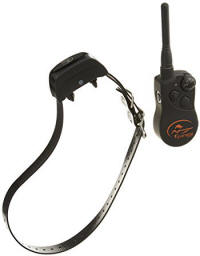 Class
65.5
Wednesday 4/19/17
Class
65.5
Wednesday 4/19/17Warm-Up :
1. How many people can we shock at one time with this Sportdog electronic collar?
2. Can we use the classroom plumbing between sinks to complete a circuit?
Today:
- Return tests
- Grades are not yet in PowerSchool.
- Test corrections for multiple choice must include an explanation in order to receive credit.
- Extra credit for returned bearings will be added to this test.
- Solar power lecture extra credit will be added manually at the end of the quarter. If you attended the lecture, there should be a comment about your extra credit in PowerSchool.
- Check/discuss homeworks (20.1 Solutions 20.2 Solutions)
- 20.3 Notes and Practice
Reading:
Homework:
- None
Warm-Up :
No Warm-up
Today:
- Get 20.2 -- Notes and Practice
- Test
- Start homework
Reading:
Homework:
- Read through Mr. Pennington's filled-in notes on Chapter 20.2. Read Chapter 20.2 Complete 20.2 practice questions and problems. 20.2 -- Notes and Practice Solutions
- If you want a clearer understanding of Voltage (a.k.a. electric potential, or, simply, potential), read Chapter 19.1.
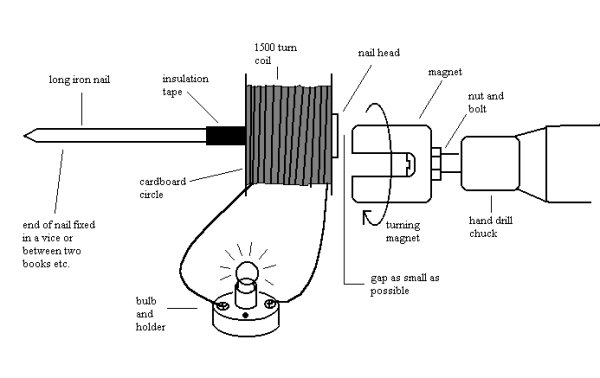
 Class
64.5
Monday 4/17/17
Class
64.5
Monday 4/17/17Warm-Up :
The pictures on the right show a battery, a generator, aVan de Graaff
machine, and some capacitors. Which one(s) can shock you
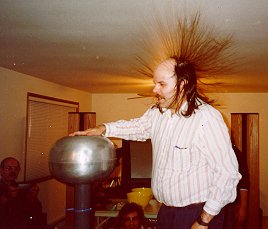 without
you completing a circuit?
without
you completing a circuit?
Today:

- Questions about the test?
- Check/discusss homework. Practice: 20.1 Solutions
- Notes: 20.2 -- Ohms Law, Resistance and Simple Circuits Key
- Electrical shock and grounding
Reading:
Homework:
- Prepare for the test.
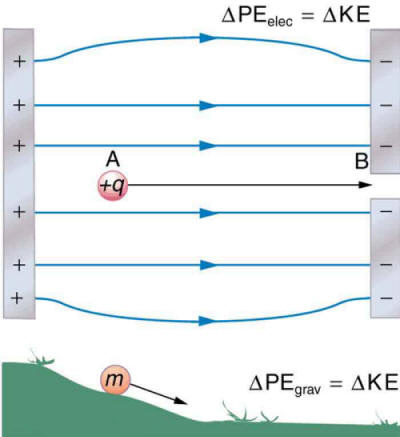 Class
64
Friday 4/14/17
Class
64
Friday 4/14/17Warm-Up :
Voltage : Potential Energy :: Electric Field : Force
1. The units for electric field are N/C. According to the analogy above, what are the units for voltage?
2. Because of its relationship to potential energy, Voltage is also referred to as electrical potential. Given the units of voltage, how many Joules of PEE would be stored in stored in a 5C charge at 3V of electrical potential?
Today:
- "4 Minute Drill"
- Questions about the test? There will also be time on Monday for questions.
- Silly video -- "Brainacs" getting shocked by an electric fence. Mythbusters peeing on the third rail of a railroad track.
- Notes: 20.1 -- Current Key
- Notes: 20.2 -- Ohms Law, Resistance and Simple Circuits Key
Reading:
Homework:
- Prepare for the test.
- Practice: 20.1 Solutions
 Class
63.5
Thursday 4/13/17
Class
63.5
Thursday 4/13/17Warm-Up :
1. In the diagram on the right, which charge is stronger?
2. How can you determine the relative strengths of the charges in the diagram?
Today:
- Get Test Review
- Go over homeworks: Electric Field Simulation, 18.5 Practice, 18.7 Practice
Reading:
Homework:
- Look over the study guide. If you have any questions, be prepared to ask them tomorrow in class.
 Class
62.5
Tuesday 4/11/17
Class
62.5
Tuesday 4/11/17Warm-Up : The nearest diagram on the right shows a uniform electric field.
1. In which direction would a negative charge accelerate if it were placed in this electric field?
2. Which of the other two diagrams correctly portrays a conductor placed in a previously uniform electric field?
Today:
- Quizzes are graded. Corrections and old tests/quizzes are not.
- I will record only quiz grades over 90% unless you give me other directions.
- Return Quizzes. Discuss answers. If you really don't want to hear the answers, because you want to do corrections (or because you haven't taken the quiz), please leave the room while we go over the answers.
- Go over Homework.
- Notes: 18.7 -- Conductors and Fields in Static Equilibrium. Notes 18.7 Key
Reading:
Homework:
- If we don't get to the notes in class, watch this video to complete the notes. Then complete: Chapter 18.7 Practice 18.7 Practice Solutions
 Class
62
Monday 4/10/17
Class
62
Monday 4/10/17Warm-Up :
1. Why do John's electrons flow into the doorknob?
2. Why do his electrons keep flowing into the doorknob, no matter how many times he gets discharged?
Today:
- Grades updated. Return papers.
- Quiz
- Notes: 18.5 -- Electric Field Lines: Multiple Charges Notes: 18.5 -- Key
- Notes: 18.7 -- Conductors and Fields in Static Equilibrium. Notes 18.7 Key
Reading:
Homework:
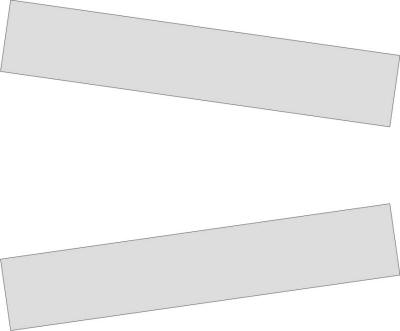 Class
61.5
Friday 4/7/17
Class
61.5
Friday 4/7/17Warm-Up :
The two plates on the right are conductors. The top plate has a net positive charge, and the bottom plate has a net negative charge.
1. In the vicinity of the plates, where is the electric field strongest?
2. What is the direction of the electric field?
3. How are the charges distributed within the plates?
Today:
- Grades will be completed and entered by Monday. Hopefully sooner.
- Look at some electric field lines.
- Check/discuss homework
- Quiz study guide Key to Travoltage and Balloon/sweater Simulations
- Notes 18.5 (Electric Field Lines). Filled in Notes: 18.5
- Simulation -- Electric Charges and Fields
Reading:
Homework:
- Quiz next class. You can drop it if you want. If you drop the quiz and you have extra credit for returned bearings, an equivalent amount of extra credit will instead be added to your next test..
 Class
61
Thursday 4/6/17
Class
61
Thursday 4/6/17Warm-Up :
Coulomb's law (snipped from the textbook) is stated on the right.
1. Why is there an absolute value symbol?
2. What happens to the forces exerted on two charges by one another if one of the charges doubles?
3. What if both of the charges double?
4. What if the distance between them doubles?
Today:
- Check/discuss homework
- Notes 18.4 (Electric Field) -18.5 (Electric Field Lines). Filled in Notes: 18.4 18.5
- Simulation -- Electric Charges and Fields
- Extra credit for bearing return or extra-special cars. Ask for details.
- Clean up/sort car stuff. Disassemble unwanted cars. Either present your car and explain that you are going to keep it or present your bearings. Get checked off.
Reading:
Homework:
 Class
60.5
Wednesday 4/5/17
Class
60.5
Wednesday 4/5/17Warm-Up :
Figure B on the right shows the distribution of excess charge on an isolated positively charged conductor with an irregular shape.
1. Why does excess charge move to the outside surface of a conductor?
2. In diagram B, it looks like positive charges moved to the outside of the conductor. Why can't this happen? What really happened?
3. In diagram B, why aren't the charges evenly distributed around the perimeter of the object? Why are they closest at the pointiest parts and farthest at the flattest parts?
Today:
- B8 -- watch static fire video.
- Check/discuss homework. Ch 18.2 practice solutions Key to Travoltage and Balloon/sweater Simulations
- Ch. 18.3 Notes -- Coulomb's Law key
- Clean up/sort car stuff. Disassemble unwanted cars. Either present your car and explain that you are going to keep it or present your bearings. Get checked off.
Reading:
Homework:
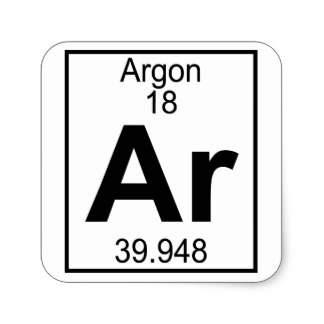
 Class
60
Tuesday 4/4/17
Class
60
Tuesday 4/4/17Warm-Up :
1. How many electrons are there in 80g of Argon atoms?
2. How would you calculate the total charge of that many electrons?
3. What is an
electrical ground?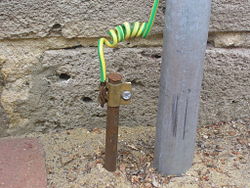
Today:
- Check/discuss homework. Video clip: Frog legs dancing with a little salt.
- Notes 18.2 Conductors and Insulators Key to notes
- VDG (Pith ball, pie pans pencil, field indicator and unreliability of triboelectric series) and Electrophorus demos of charging by induction. [Green indicator light means approaching increasing electric field, approaching positive charge.]
- Clean up/sort car stuff. Disassemble unwanted cars. Either present your car and explain that you are going to keep it or present your bearings. Get checked off.
- Good explanation of how the classroom Van de Graaff Generator works -- but backward relative to our classroom VDG.
Reading:
Homework:

Warm-Up :
1. If you rub a balloon on your head and then hold it next to your hair, your hair is attracted to the balloon. Why?
2. Your hair may also stand on end after being rubbed by a balloon. Why?
3. The balloon may stick to the wall or ceiling. Why?
4. This all works better in drier air. Why?
Today:
- Notes 18.1 Static electricity and Charge Key to Notes
- Notes 18.2 Conductors and Insulators Key to notes
- Van de Graaff Generator
- Clean up/sort car stuff. Disassemble unwanted cars.
Reading:
Homework: Chapter 18.1 Practice -- Static Electricity and Charge Solutions
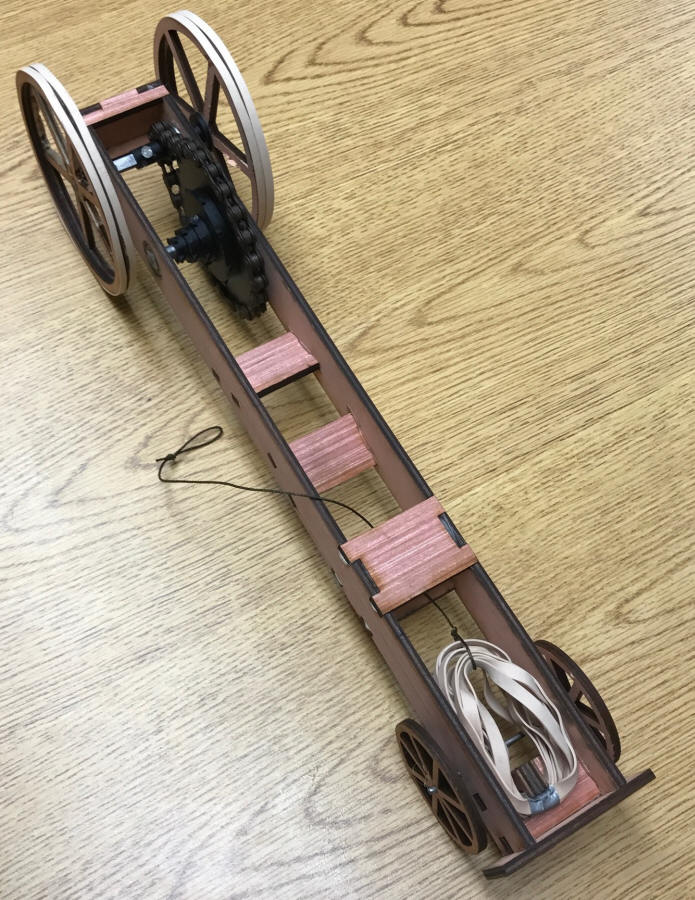 Class
59
Friday 3/31/17
Class
59
Friday 3/31/17Warm-Up :
To wind up the car on the right, a string is hooked on a tab on one of the stair-step radii of the large chain ring, and the wheels are rotated backward until the rubber bands almost reach the chain ring.
1. What is the purpose of the chain?
2. What is the purpose of the stair-step design of the front chain ring?
3. What advantage(s) does using a string confer?
4. Sum up the guiding principle that was followed in order to design a car that would go as fast as possible.
5. Why wouldn't the car go as fast if the string was merely wrapped around the bare axle, with the same amount of rubber band stretch?
Today:
- Last day of car project work
- Project Stuff relating to Rhino -- Rhino information, files, etc.
- Slideshows should be finished and shared with Mr. Stapleton before the end of school on Friday. If your isn't ready to be graded, insert a new slide at the very beginning that says something like "not finished! Please do not grade!". If you do not finish this on Friday, do not expect fast grading turnaround time.
Reading:
Homework:
- Chapter 18 Reading
- Finish slideshow. If you don't finish by the end of school on Friday, insert a slide at the beginning that says "Not finished. Do not grade." Then, when your slideshow is finished, email me to let me know.
- Document your car's success in one of the following ways:
- Have me watch your car jump to the string or beyond.
- Show me a video of your car jumping to the string or beyond.
- Share an uploaded video showing your car reaching or surpassing 3.4m/s. Include your calculations of your car's top speed.
Warm-Up :
The speed required to jump 1m is 3.4m/s. A car is videoed at a frame rate of 240 frames per second. If the car passes over a floor tile (0.305m) in 21 frames, has its speed reached 3.4m/s?
Today:
- Return Tests
- Test cars.
- Project Stuff relating to Rhino -- Rhino information, files, etc.
- Slideshows should be finished and shared with Mr. Stapleton before the end of school on Friday. If your isn't ready to be graded, insert a new slide at the very beginning that says something like "not finished! Please do not grade!". If you do not finish this on Friday, do not expect fast grading turnaround time.
Reading: None
Homework:
- Finish slideshow. If you don't finish by the end of school on Friday, insert a slide at the beginning that says "Not finished. Do not grade." Then, when your slideshow is finished, email me to let me know.
- Document your car's success in one of the following ways:
- Have me watch your car jump to the string or beyond.
- Show me a video of your car jumping to the string or beyond.
- Share an uploaded video showing your car reaching or surpassing 3.4m/s. Include your calculations of your car's top speed.
Warm-Up :
No warm-up today
Today:
- Test.
- Silent car work time. Project Stuff relating to Rhino -- Rhino information, files, etc.
- Slideshows should be finished and shared with Mr. Stapleton before the end of school on Friday. If your isn't ready to be graded, insert a new slide at the very beginning that says something like "not finished! Please do not grade!"
Reading: None
Homework:
- Slideshow
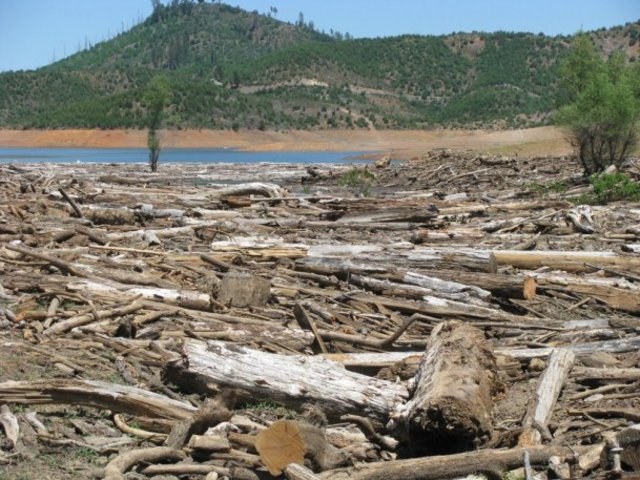 Class
57
Monday 3/27/17
Class
57
Monday 3/27/17Warm-Up :
Suppose you need to want to build a camp fire. You have plenty of dry wood, but it's all big limbs that are too long to be manageable, and too thick to break over your knee. Without using a saw or an axe, what's the best way to divide wood into smaller pieces? Can you describe the proper technique? One solution.
Today:
- Check for completion of test reviews.
- Questions about the test on Wednesday? It will be similar to the two test reviews. You will be given the formulas that were listed on the first test review.
- Car work time
- Updated Schedule
- Work on cars. Project Stuff relating to Rhino -- Rhino information, files, etc.
- Slideshows should be finished before the end of school on Friday.
Reading: None
Homework:
- Study for test on Wednesday.
Warm-Up :
No warm-up. Work on cars.
Today:
- Announcements:
- Spacers are in a manilla (?) envelope.
- Don't forget to keep updating your slideshow as your car progresses. If you don't, you may realize that you don't have the materials or files that you need for your slides.
- You really should complete the test review, check your answers, and watch the necessary videos before Monday. Monday is for asking about parts of the review that were unclear in the videos.
- Car Project Final Days:
- You may work on cars today, on Monday (unless you're involved in test review), Wednesday after the test, and a little bit on Thursday.
- Thursday is going to be the official testing day for the cars.
- Slideshows are due on Friday.
- You may keep improving your car outside of class time. Improved car performance can raise your grade accordingly.
- If I have time, I will laser cut some more cars. If you want me to do this, send me your completed file with a clear explanation of what you need. I will cut cars in the order recieved in each class.
- Updated Schedule
- Work on cars. Project Stuff relating to Rhino -- Rhino information, files, etc.
- Slides 7 and 8 should be complete by today.
Reading: None
Homework:
- Complete Test Review Version 2, Rotational Motion by Monday. Check your answers with the Solutions. If you don't understand the solutions, watch the videos below. Come to class on Monday with unanswered questions.
Warm-Up :
No warm-up. Work on cars.
Today:
- Updated Schedule
- Work on cars. Project Stuff relating to Rhino -- Rhino information, files, etc.
- Slides 7 and 8 should be complete by today.
Reading: None
Homework:
- Complete Test Review Version 2, Rotational Motion by Monday. Check your answers with the Solutions. If you don't understand the solutions, watch the videos below. Come to class on Monday with unanswered questions.
- If you need help scaling up your car, send a file of your assembled car (or whatever you have) to Mr. Stapleton and clearly explain what you need to have done.
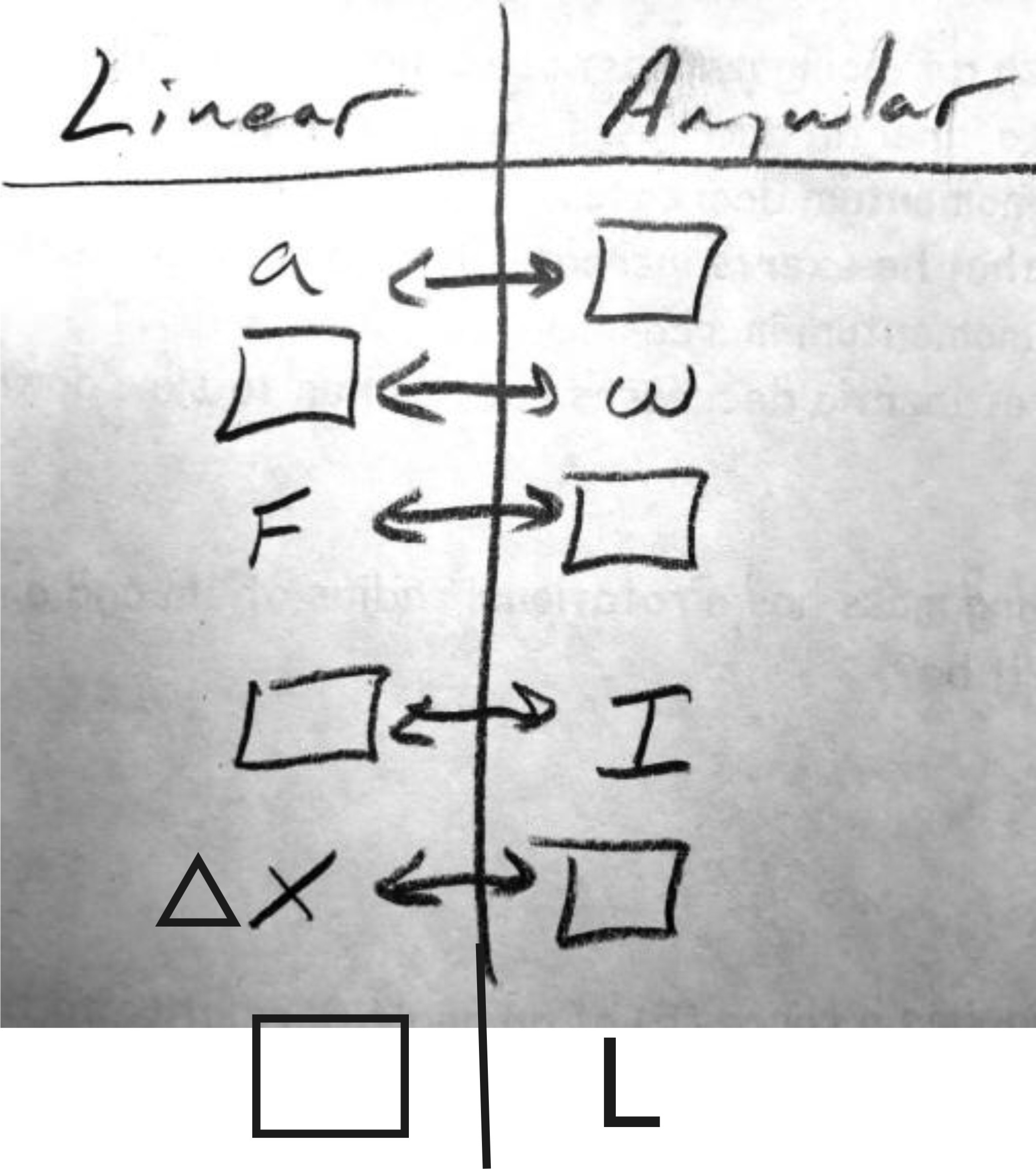 Class
55.5
Wednesday 3/22/17
Class
55.5
Wednesday 3/22/17Warm-Up :
1. The table on the right lists analogous linear and angular measurements. Fill in the boxes witht the right measurements.
2. For which of the measurements on the right can you perform a simple conversion from the linear to the angular form, or vice versa?
3. For those measurements, what is the conversion?
Today:
- Any questions about Spring Car Problems Part 3? (Solution)
- Updated Schedule
- Hand out Test Review, Version 2 (link below)
- Work on cars. Project Stuff relating to Rhino -- Rhino information, files, etc.
- If you have a file that is ready to laser cut, but you don't have time to cut it yourself, email it to me and specify the material. I might be able to cut it before next class.
Reading: None
Homework:
- Finish slides 7 and 8 by next class.
- Complete Test Review Version 2, Rotational Motion by Monday. Check your answers with the Solutions. If you don't understand the solutions, watch the videos below. Come to class on Monday with unanswered questions.
- If you need help scaling up your car, send a file of your assembled car (or whatever you have) to Mr. Stapleton and clearly explain what you need to have done.
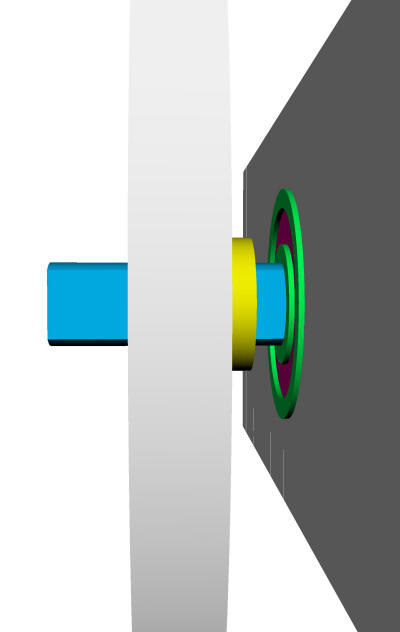
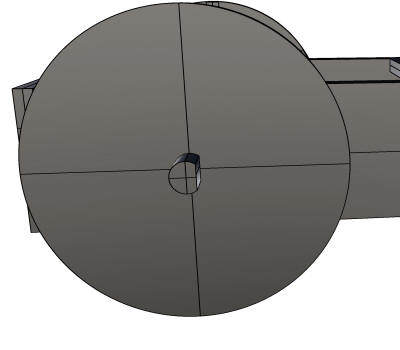 Class
54.5
Monday 3/20/17
Class
54.5
Monday 3/20/17Warm-Up :
1. In Rhino, how do you create a D-shaped hole in a wheel?
2. The second picture on the right shows a light grey wheel, a dark grey car frame, a green and pink bearing, and a yellow spacer. What is the purpose of the spacer? Why was that particular radius chosen for the spacer?
Today:
- Scheduling Update:
- SBAC makeup will be on Tuesday, 3/28. We will not have the car competition that day.
- Rotational Motion Test will still be on Wednesday, 3/29.
- Car competition will be moved to Thursday, 3/30.
- Car slideshows will be due by the beginning of class on Friday, 3/31.
- Hand out Spring Car Problems Part 3
- Work on cars. Project Stuff relating to Rhino -- Rhino information, files, etc.
- If you have a file that is ready to laser cut, but you don't have time to cut it yourself, email it to me and specify the material. I might be able to cut it before next class.
Reading: None
Homework:
- Complete slides 5 and 6.
- Complete Spring Car Problems Part 3. Check your answer (Solution). If you have questions, watch the video ( Link to Video). If you still have questions, ask them in class on Wednesday.
- If you need help scaling up your car, send a file of your assembled car to Mr. Stapleton and explain what you need.
 Class
54
Friday 3/17/17
Class
54
Friday 3/17/17Warm-Up :
Suppose you need three squares of toilet paper, and one of your hands is unavailable.
1. What strategy might you use to tear off only three squares?
2. Why is this task easier with a nearly-full roll?
Today:
- Check/Discuss homework.
- Check in regarding who has shared the slideshow.
- Schedule for the rest of the project/unit.
- How to adjust your cardboard model (0.13" thick) to work with wood (0.19" thick). If your car is not very big, the easiest way is to simply scale your entire model by 1.46. For a 3-D model, use the Scale-3D command under the Transform tab.
- Work on cars. Project Stuff relating to Rhino -- Rhino information, files, etc.
Reading: None
Homework:
- Due on Tuesday -- complete slideshow slides 1-4. Most of you should be able to complete slide 5, and possibly slide 6.
Warm-Up :
No warm-up today
Today:
- Tomorrow we will go over the homework that was due today and tonight's homework.
- Work on cars. Project Stuff relating to Rhino -- Rhino information, files, etc.
Reading: None
Homework:
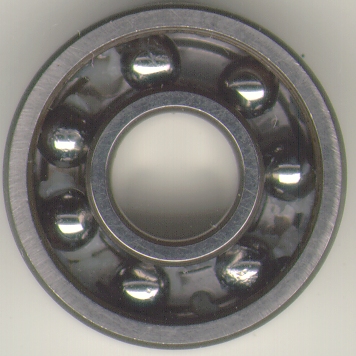 Class
53
Monday 3/13/17
Class
53
Monday 3/13/17Warm-Up :
1. What is the function of the steel spheres in this bearing?
2. A bearing reduces friction, but it is not frictionless. What are the sources of friction in this bearing?
3. If the inner ring has an outer diameter of X, and the spheres have radii of X/2, exactly how many revolutions do the spheres make for every rotation of the inner ring (assuming that the outer ring remains motionless)?
4. How many revolutions do the spheres make if the outer ring makes one rotation and the inner ring stays still?
5. What if each ring (outer and inner) makes 1 rotation, but in an opposite direction?
Today:
- Check/Discuss homework
- Saving time at the laser cutter -- cut several cars in the same rhino window using the import function
- Where to find wood (near the Fab Lab)

- Don't forget about gathering material for your slide show. Car project slideshow template
- Work on cars. Project Stuff relating to Rhino -- Rhino information, files, etc.
Reading: None
Homework:
 Class
52.5
Friday 3/10/17
Class
52.5
Friday 3/10/17Warm-Up :
The picture on the right shows one of the elasticar bearings.1. Which part(s) of the bearing should touch the frame of your car?
2. Which part(s) of the bearing should touch your car's axle?
3. Which parts can touch your wheel?
4. For a non-drive axle, your answers to 1-3 could be different. Explain.
Today:
- Check/Discuss homework
- Don't forget about gathering material for your slide show. Car project slideshow template
- Work on cars. Start laser cutting. Project Stuff relating to Rhino -- Rhino information, files, etc.
Reading: None
Homework:
- Complete Problems 4-6 of Rotational Motion Test Review Solutions
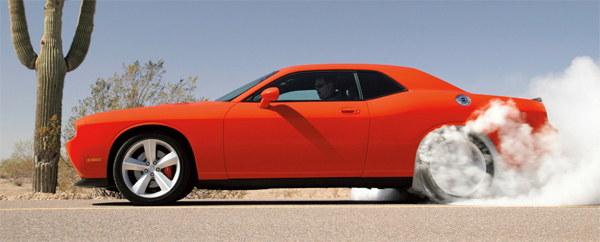 Class
52
Thursday 3/9/17
Class
52
Thursday 3/9/17Warm-Up : Suppose your rubber band car doesn't have enough traction. The wheels are spinning out.
1. What is the root of the problem?
2. What are some ways to prevent your wheels from slipping?
3. Do your solutions have costs? If so, what are they?
Today:
- Check/Discuss homework
- Take safety test.
- Work on cars. Start laser cutting. Project Stuff relating to Rhino -- Rhino information, files, etc.
Reading: None
Homework:
- Complete Problems 1-3 of Rotational Motion Test Review Solutions
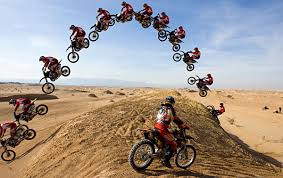 Class
51.5
Wednesday 3/8/17
Class
51.5
Wednesday 3/8/17Warm-Up :
1. A dirt bike rider goes off a jump at a speed of 30mph. In mid-air, the rider hits the brakes, stopping the tires' rotation. What effect does this braking have on the whole motorcycle?
2. If I roll a roll of tape away from me with the
tilt shown in the photo, what will happen? Why?
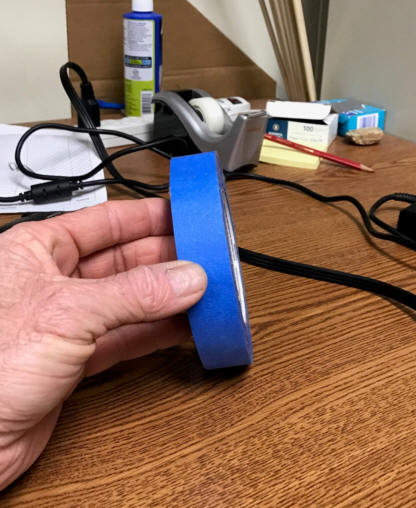
Today:
- Awards for projectile competition
- Laser cutter safety information
- Car work time
- Project Stuff relating to Rhino -- Rhino information, files, etc.
Reading: None
Homework:
- Complete Multiple Choice (#1-19) of Rotational Motion Test Review
- Quiz next class over the laser cutter rules and produres.
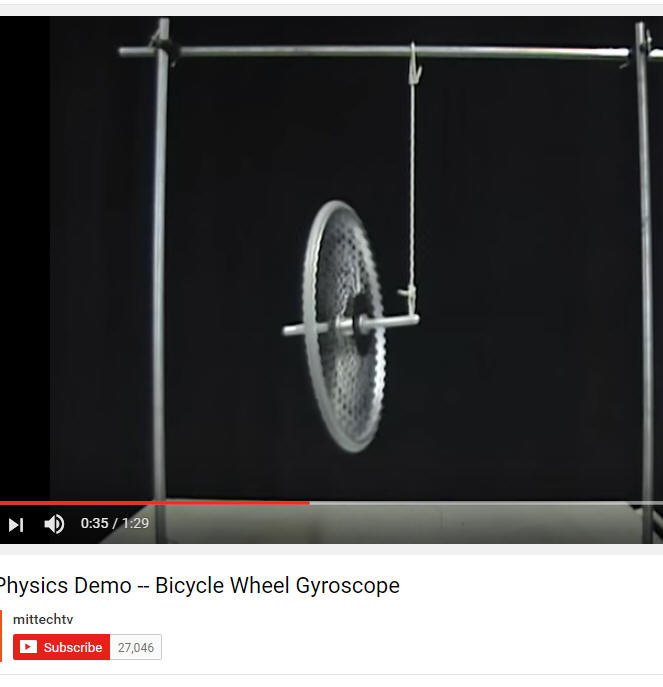 Class
51
Thursday 2/24/17
Class
51
Thursday 2/24/17Warm-Up :
The bicycle tire in the picture on the right has two motions; it is rotating around its axle, and it is precessing around an axis alont the rope's length. Why does it precess in one particular direction?
Today:
- Car work time
- Rhino Stuff
- Link to Download page for 90 day trial version of Rhino (PC and Mac versions available)
- File with Axle and Bearings. You can download this and import it into your file, if you want. It contains bearings with a 0.86" outer radius on a 5/16" (0.3125") axle.
- How to print, once you have made your file, and you're in the Fab Lab
- Rhino Basic Skills
- Complete Cardboard Box Directions (from earlier class)
- Video showing the creation of a box in Rhino
- More useful commands for car making:
- In the Osnap options, enable cen, so that you can align things to the center of any circular shape.
- Cylinder (under the Solid menu) is good for cutting holes and making axles. I recommend switching your input mode to diameter using the command prompt box.
- Control point curve
- Extrude curve straight
- Extrude surface
- Trim
Reading: None
Homework:Prepare for a quiz (Thursday after break) over the laser cutter rules and produres.
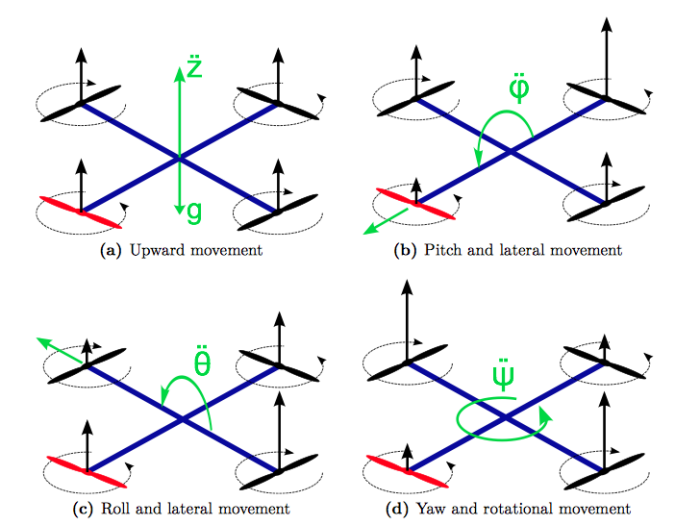
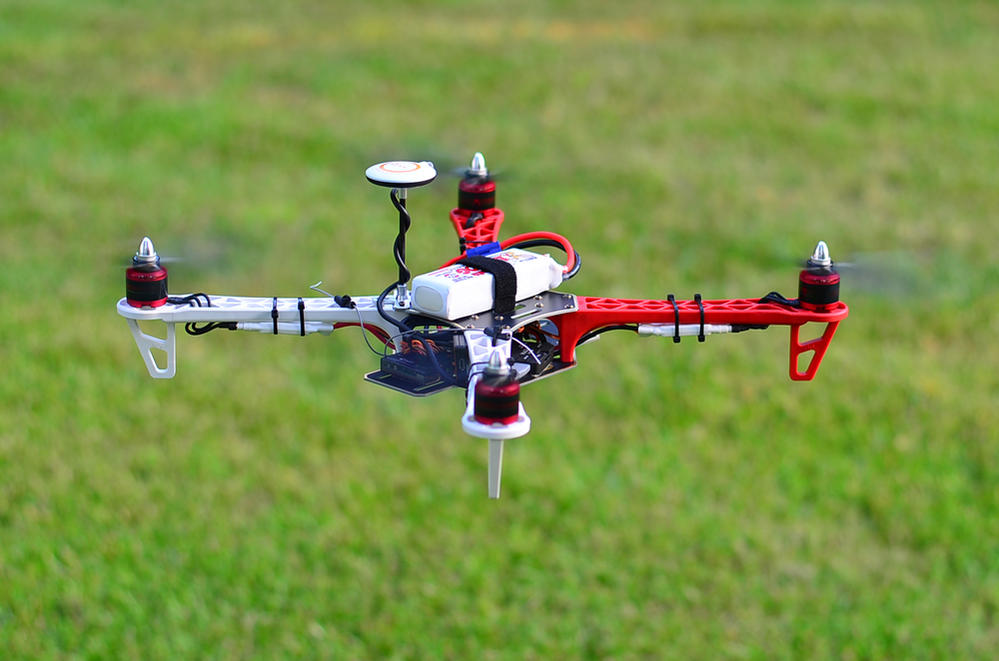 Class
50.5
Thursday 2/23/17
Class
50.5
Thursday 2/23/17Warm-Up :
- A quadcopter has four propellers. Why do the propellers alternate in their directions of rotation?
- How does a quadcopter achieve a yaw (rotation around a vertical axis) without also rising or sinking? How does this work?
- How does a stationary quadcopter begin to fly forward? Why does this work?
Today:
- Check/discuss homework problems in problems in Notes and Practice -- Ch. 10.5: Angular Momentum
- Review the slideshow requirements.
- Work on your CAD design.
- Rhino Stuff
- File with Axle and Bearings. You can download this and import it into your file, if you want. It contains bearings with a 0.86" outer radius on a 5/16" (0.3125") axle.
- How to print, once you have made your file, and you're in the Fab Lab
- Rhino Basic Skills
- Complete Cardboard Box Directions (from earlier class)
- Video showing the creation of a box in Rhino
- More useful commands for car making:
- In the Osnap options, enable cen, so that you can align things to the center of any circular shape.
- Cylinder (under the Solid menu) is good for cutting holes and making axles. I recommend switching your input mode to diameter using the command prompt box.
- Control point curve
- Extrude curve straight
- Extrude surface
- Trim
Reading: None
Homework: Think about your car design.
 Class
50
Wednesday 2/22/17
Class
50
Wednesday 2/22/17Warm-Up :
- How do falling cats always manage to land on their feet?
- Why do falling people flail their arms around?
Today:
- Check-in regarding the homework (slideshow sharing, sketch(es), video -- 8 views)
- Notes and Practice -- Ch. 10.5: Angular Momentum
- Work on your CAD design.
- Rhino Stuff
- How to print, once you have made your file, and you're in the Fab Lab
- Rhino Basic Skills
- Complete Cardboard Box Directions (from earlier class)
- Video showing the creation of a box in Rhino
- More useful commands for car making:
- In the Osnap options, enable cen, so that you can align things to the center of any circular shape.
- Cylinder (under the Solid menu) is good for cutting holes and making axles. I recommend switching your input mode to diameter using the command prompt box.
- File with Axle and Bearings. You can download this and import it into your file, if you want. It contains bearings with a 0.86" outer radius on a 5/16" (0.3125") axle.
Reading:
Homework: Complete the problems in Notes and Practice -- Ch. 10.5: Angular Momentum
Warm-Up :
- How fast is the world record figure skating spin, in rpm?
- During the spin, do you suspect that the skater's angular momentum is increasing, decreasing, or staying the same?
- What about the skater's rotational KE?
Today:
- Check/discuss Rotational KE practice problems in Notes and Practice -- Rotational KE.
- Elasticar group form
- Make a copy of the Car project slideshow template. Share it with your partner and Mr. Stapleton.
- Paste your car design sketch(es) into your slideshow.
- Work on your CAD design.
Reading:
-
Chapter 10.4: Rotational KE -- work and energy revisited
Homework:
- Make a copy of the Car project slideshow template. Share it with your partner and Mr. Stapleton.
- Paste your car design sketch(es) into your slideshow.
- Watch this video showing how to laser cut in the Fab Lab using Rhino.
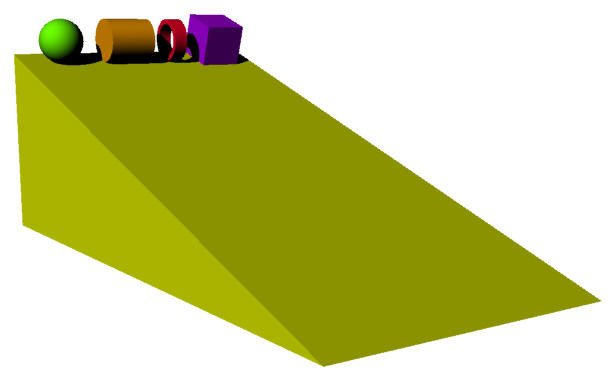 Class
49
Monday 2/20/17
Class
49
Monday 2/20/17Warm-Up : A sphere, a cylinder, a ring, and a frictionless box are released from rest at the top of ramp.
1. Consider the changes in the objects' KE and PE during the trip down the ramp.
2. Rank the objects according to their arrival times at the bottom of the ramp.
3. The round objects are affected by friction. Would the result be different in a totally frictionless situation? Explain.
Today:
- Notes and Practice -- Rotational KE
- Return and assemble boxes.
- Elasticar group form
- Group issue in 5/6.
- Begin car design work. Car Project Outline
- Car project slideshow template -- your project will be submitted as a slideshow.
Reading:
-
Chapter 10.4: Rotational KE -- work and energy revisited
Homework:
- Complete Rotational KE practice problems in Notes and Practice -- Rotational KE.
- As a group, create at least one 2-D sketch of your car. Do this before creating your rhino model.
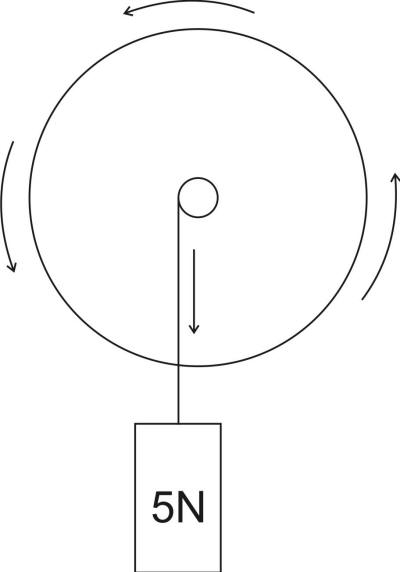 Class
48.5
Friday 2/17/17
Class
48.5
Friday 2/17/17Warm-Up : Starting from rest, the wheel and the axle shown on the right are rotated by a falling weight that is tied to a string. The string is wrapped around the axle, and the axle and the wheel are fused together.
How could you find the moment of inertia (I) of the wheel and axle? What materials would you need?
Today:
- Check/discuss homework. 10-3 Rotational Inertia Practice Rotational Inertia practice Solutions
- Laser cut boxes?
- Car groups. Do we have an uneven number?
- Begin car design work. Car Project Outline
Reading:
Homework:
- Think about your car design. Brainstorm and begin 2-D sketches (pencil and paper).
Warm-Up
:
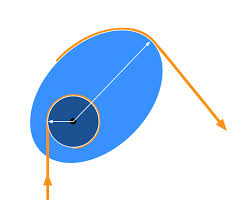 What
purpose(s) do the pulleys of a compound bow serve?
What
purpose(s) do the pulleys of a compound bow serve?
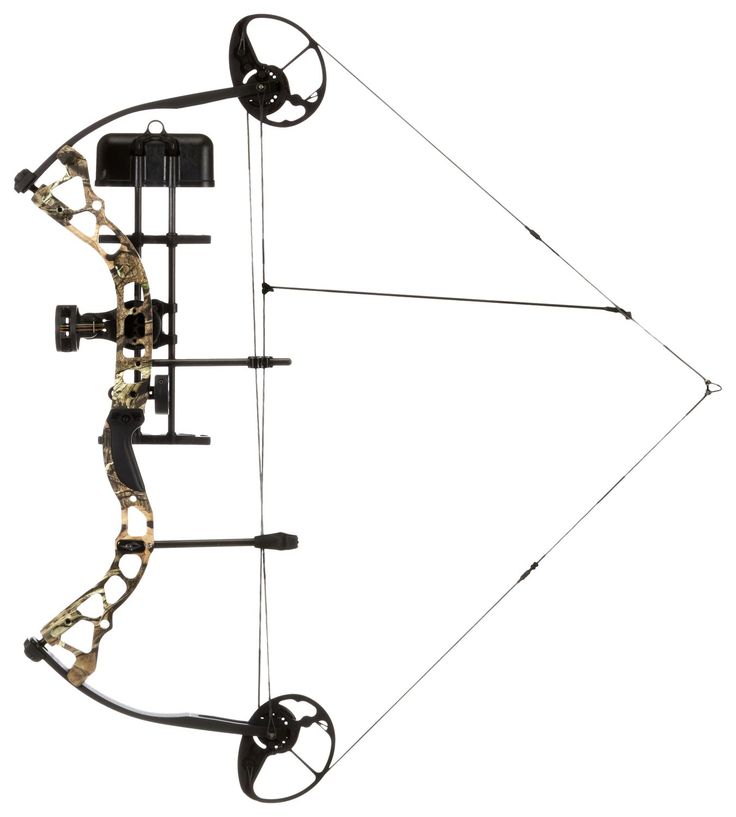
Today:
- Rotational Inertia Notes: 10-3 Rotational Inertia Notes (Pennington) Rotational Inertia Notes Key. Then complete the practice problems. 10-3 Rotational Inertia Practice Rotational Inertia practice Solutions
- Prepare boxes for laser cutting. Box directions PDF
- Begin car design work. Car Project Outline -- tentative
Reading:
Homework:
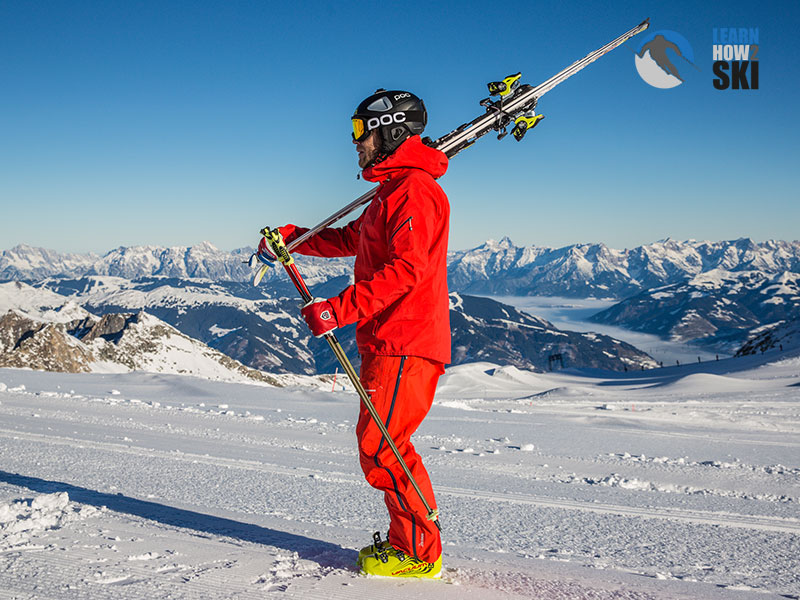 Class
47.5
Wednesday 2/15/17
Class
47.5
Wednesday 2/15/17Warm-Up :
Why is it easier to carry skis at a tilt (as shown on the right), rather than keeping them horizontal?
Today:
- Check/discuss homework. Torque Practice (Pennington) Torque Practice Solutions
- Rotational Inertia Notes: 10-3 Rotational Inertia Notes (Pennington) Rotational Inertia Notes Key. Then complete the practice problems. 10-3 Rotational Inertia Practice Rotational Inertia practice Solutions
- Tomorrow (or Friday, if there's a snow day tomorrow) -- meet in
library computer lab.
- prepare boxes for laser cutting.
- Work on car design.
Reading:
Homework:
- None
Warm-Up : Assuming equal coefficients of friction, will one of the two ski jumps, on the right, will result in the jumper traveling a greater distance? If so, which one? Explain your reasoning.
Today:
- Fill in Torque Notes (Pennington) . A7/8, complete the notes using this Torque Notes Key
- Complete Torque Practice (Pennington) Torque Practice Solutions
- Do you need to finish your box? If so, you can finish it on a classroom computer.
- If you want to get ahead... fill in 10-3 Rotational Inertia Notes (Pennington) Rotational Inertia Notes Key. Then complete the practice problems. 10-3 Rotational Inertia Practice Rotational Inertia practice Solutions
Reading:
Homework:
- Finish Torque Practice (Pennington) --due tomorrow. Solution link provided above.
- 10-3 Rotational Dynamics Practice will be due on Thursday.
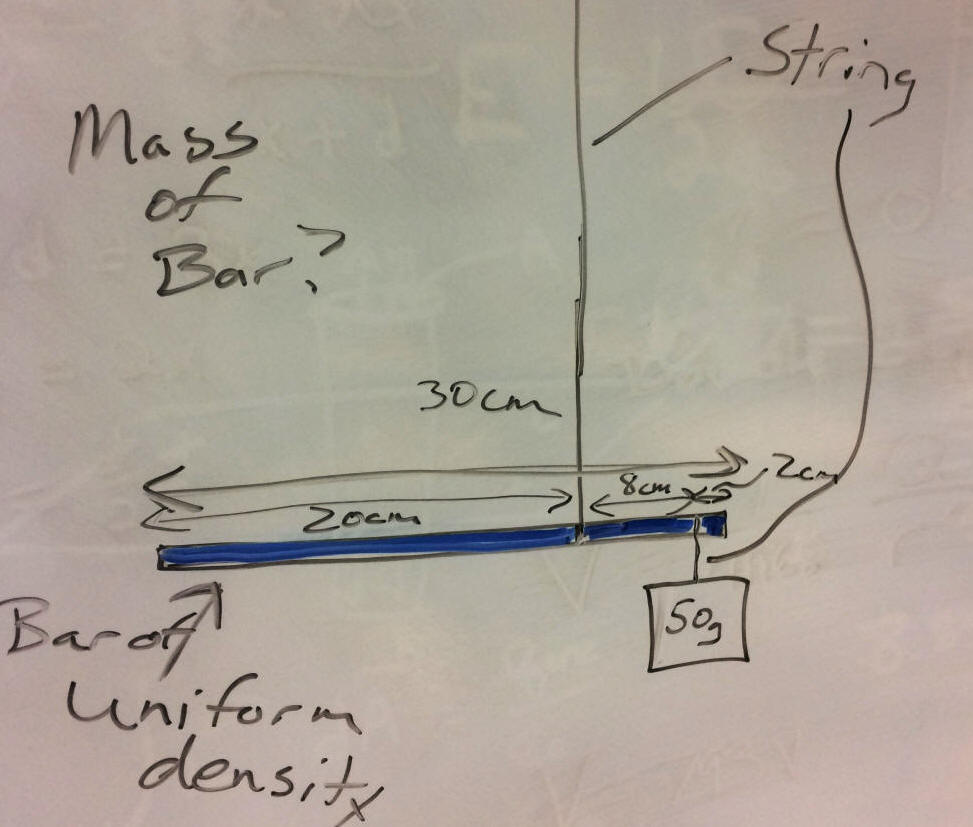 Class
46
Friday 2/10/17
Class
46
Friday 2/10/17Warm-Up : What is the mass of the balanced bar on the right?
Today:
- Torque Notes (Pennington) Torque Notes Key
- Finish box designs.
- Rotational Dynamics PowerPoint
Reading:
Homework:
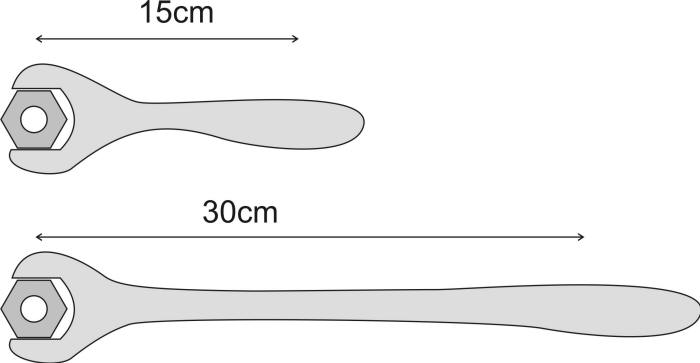 Class
45.7
Thursday 2/9/17
Class
45.7
Thursday 2/9/17Warm-Up :
Torque = Force x Radius.
Using the shorter wrench, a 40N force must be applied 15cm from the nut's center in order to loosen the nut.
1. How much torque is required to loosen the nut?
2. How much force must be applied in order to loosen the nut using the longer wrench? (assuming the force is applied at a distance of 30cm from the nut's center)
Today:
- Next class - meet in library computer lab.
- Check/discuss homework: Rotational Acceleration Intro ["practice problems with angular acceleration, continued" (#6, 7, and 16-19)] Solutions to p3 Stapleton solutions
- Work on you cardboard box design. There must be at least two jogs in every edge of the box. Cardboard thickness is 0.13 inches. The longest box dimension should be 2". You might want to make a puzzle cube. You may use any CAD software, but I will show you how to use Rhino.
- 7/8 --Solution to extra credit problem -- radius of the loop?
- Rotational Dynamics PowerPoint
Reading:
Homework: Optional torque problem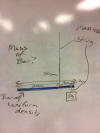
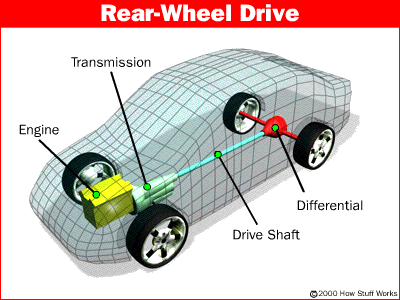 C
C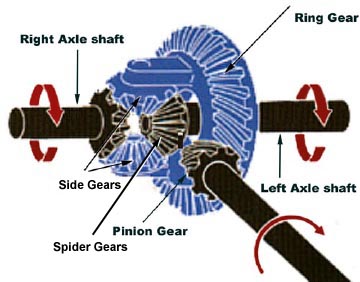 lass
47
Wednesday 2/8/17
lass
47
Wednesday 2/8/17Warm-Up :
1. What does a differential do?
2. How does a differential work?
Today:
- Check/discuss homework Solutions to p1-2
- Design a laser-cut "dovetail" cardboard box. There must be at least two jogs in every edge of the box. Cardboard thickness is 0.13 inches. The longest box dimension should be 2". You might want to make a puzzle cube. You may use any CAD software, but I will show you how to use Rhino.
- 7/8 --Solution to extra credit problem -- radius of the loop?
- Rotational Dynamics PowerPoint
Reading:
Homework:
- Complete "practice problems with angular acceleration, continued" (#6, 7, and 16-19) Solutions to p3
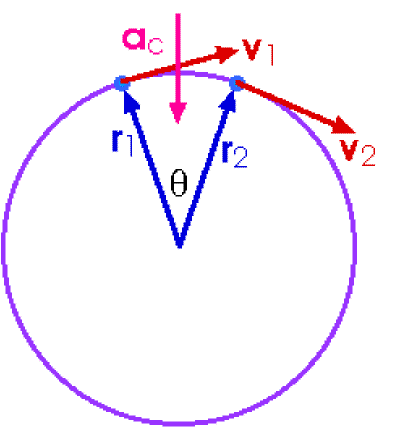 Class
46.5
Tuesday 2/7/17
Class
46.5
Tuesday 2/7/17Warm-Up :
Can you guess the difference between centripetal acceleration and tangential acceleration?
Today:
- Rotational Acceleration Intro Solutions to p1-2
- Finish Quizzes. Return quizzes.
- 7/8 --Solution to extra credit problem -- radius of the loop?
- Rotational Dynamics PowerPoint
Reading:
Homework:
- Read text sections 6.1, 10, and 10.1. Complete #1-5 in Rotational Acceleration Intro Solutions to p1-2 Solutions to p3
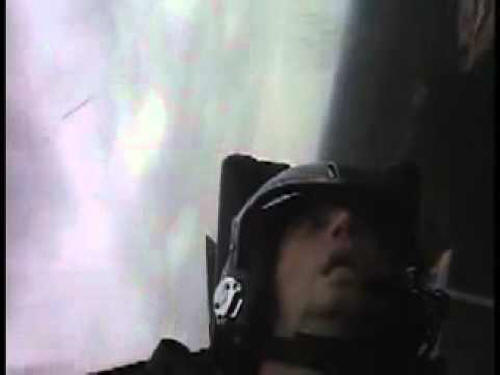 Class
46
Monday 2/4/17
Class
46
Monday 2/4/17Warm-Up :
1. True or false: as long as you are not experiencing a normal force, you feel weightless.
2. Why? What causes the sensation of weight?
3. Write a formula for the acceleration that you feel.
Today:
- Solution to extra credit problem -- radius of the loop
- Quiz: Circular Motion, Gravitation, Kepler
- Begin rotational kinematics. Rotational Dynamics PowerPoint
- Rotational Acceleration Intro Solutions to p1-2
Reading:
Homework:
- Reading, above.
 Class
45.5
Friday 2/4/17
Class
45.5
Friday 2/4/17Warm-Up : Practice with radians
1. 360º = _____ radians
2. 90º = _____ radians
3. 2 radians = _____ degrees
Today:
- Check/discuss 13-18 of Quiz review Practice -- Circular Motion, Gravitation, Kepler Solutions
- Try out Rhino on the classroom computers. Begin designing a "dovetail" cardboard box. There must be at least two jogs in every edge of the box. Cardboard thickness is 0.13 inches. The longest box dimension should be 2". You might want to make a puzzle cube. You may use any CAD software, but I will show you how to use Rhino.
After Monday's quiz:
- Begin rotational kinematics. Rotational Dynamics PowerPoint
- Rotational Acceleration Intro Solutions to p1-2
Reading:
Homework:
- Prepare for quiz.
- Rhino is on the library computers, in case you want to work on CAD design outside of class.
 Class
45
Thursday 2/2/17
Class
45
Thursday 2/2/17Warm-Up :
In several of the problems you have encountered, a car travels around a loop-the-loop at a constant speed.
1. For this situation, sketch (or visualize) the individual forces acting on the car at points A, B, C, and D.
2. Is this a realistic problem?
3. In the video on the right, why do they say the driver experiences 6g's when he enter's the loop at the minimum speed?
Today:
- Check/discuss 1-12 of Quiz review Practice -- Circular Motion, Gravitation, Kepler Solutions
- Begin rotational kinematics. Rotational Dynamics PowerPoint
- Rotational Acceleration Intro Solutions to p1-2
Reading:
Homework:
- Due Tomorrow: Complete the rest (#13-18) of Quiz Review Practice -- Circular Motion, Gravitation, Kepler Solutions
- Due Next Tuesday: Complete questions and problems in Rotational Acceleration Intro Solutions to p1-2
- Optional extra credit -- use the minimum required speed in the Top Gear video, above, to calculate the radius of the loop. You must show and explain your work.
Warm-Up :
1. What is a geosynchronous satellite?
2. What's the difference between a geosynchronous orbit and a geostationary orbit?
Today:
- Check/discuss the remaining problems in Notes: Circles, Gravity, Kepler Solutions
Reading:
Homework:
- Complete #1-12 in Review Practice -- Circular Motion, Gravitation, Kepler
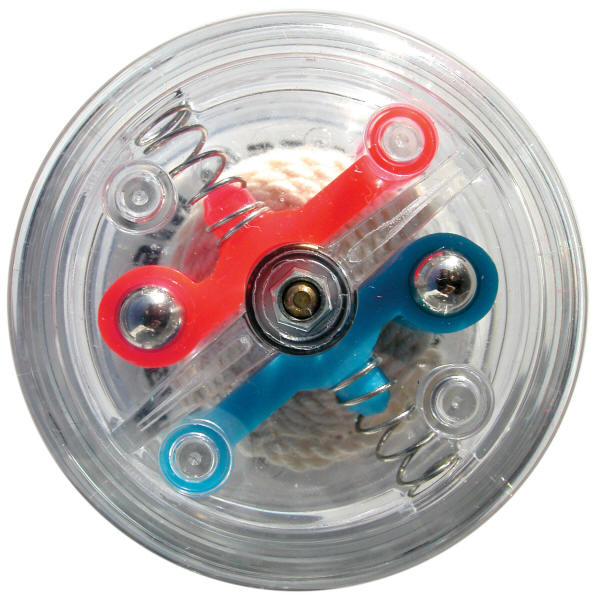 Class
44
Tuesday 1/31/17
Class
44
Tuesday 1/31/17Warm-Up :
1. How does this yo-yo work? What do the springs and steel balls do?
2. A yo-yo spins as it goes down and up. At what point in its travel does it spin fastest?
3. If you graphed the velocity of a yo-yo, would it look like
this?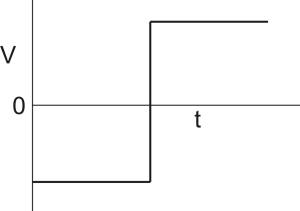
Today:
- Check/discuss
- Space odyssey video
- Discuss rest of Notes: Circles, Gravity, Kepler
- Complete the remaining problems in Notes: Circles, Gravity, Kepler Solutions
- Complete remaining problems in notes: Circles, Gravity, Kepler Solutions
Reading:
Homework:
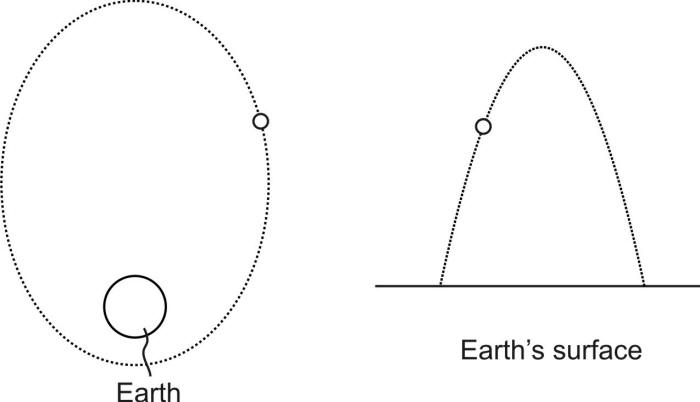 Class
43.67
Monday 1/30/17
Class
43.67
Monday 1/30/17Warm-Up :
Two flight paths are shown for objects in free-fall. How are they different? Why? Should they be different?
Today:
-
Check/discuss
Elliptical
Orbits Activity

- Notes: Circles, Gravity, Kepler Solutions solution to #10 with 3rpm
Reading:
Homework:
- Complete problems #1, 2, 10 (the circular motion #10) , and 11, in notes: Circles, Gravity, Kepler Solutions
- Reading (see above)

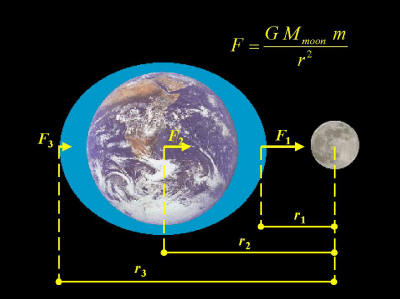 Class
43.33
Thursday 1/26/17
Class
43.33
Thursday 1/26/17Warm-Up : From last year's EPS 200 class...
The Sun, Earth, and Moon are continually spaghettifying one another. We see the effects of this spaghettification in the form of tides.
1. What causes spaghettification and tides?
2.
How much gravitational force do the Sun and Moon each exert on 1,000,000 pounds of water?
3. Is the Earth's 24 hour rotational period speeding up or
slowing down over time? Explain.
Good source of information about tides
Today:
-
Return and discuss midterms.
Hand back in.
- Pass back midterm review packets.
- Discuss grades.
- Elliptical Orbits Activity
- Notes: Circles, Gravity, Kepler
Reading:
Homework:
- complete Elliptical Orbits Activity
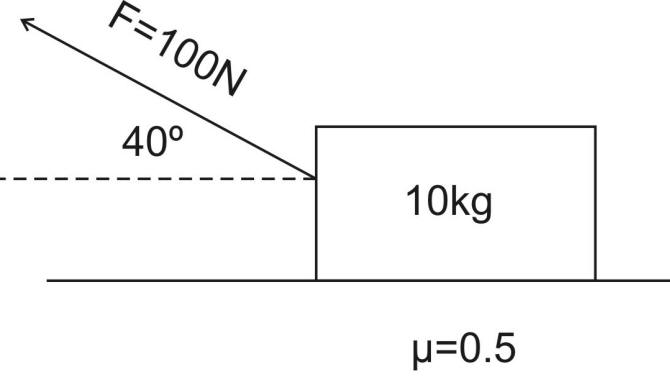 lass
43
Wednesday 1/18/17
lass
43
Wednesday 1/18/17Warm-Up :
1. What normal force is acting on the box?
2. What is the acceleration of the box?
Today:
-
Updates:
- Formula sheet -- example problems are okay
- Problem point system has changed
- Exam Summary -- Numbers and types of questions and problems
- Work time
- Mistakes discovered in answer keys:
- Work and energy -- multiple choice #9 should be choice B, not choice C.
- Packet 1 -- Kinematics vector problem #2 should be 6.1cm, 16.5 degrees N of East.
- Review packets:
- #5 -- Not a packet. Know the formulas for centripetal acceleration and centripetal force, and know how to apply them.
- #4
- #3
- #2
Homework:
- Tomorrow is our last chance to review. Bring any questions or problems that you would like to review.
- If you want to turn in your review packets for credit, turn them in with your exam and your formula sheet on exam day.
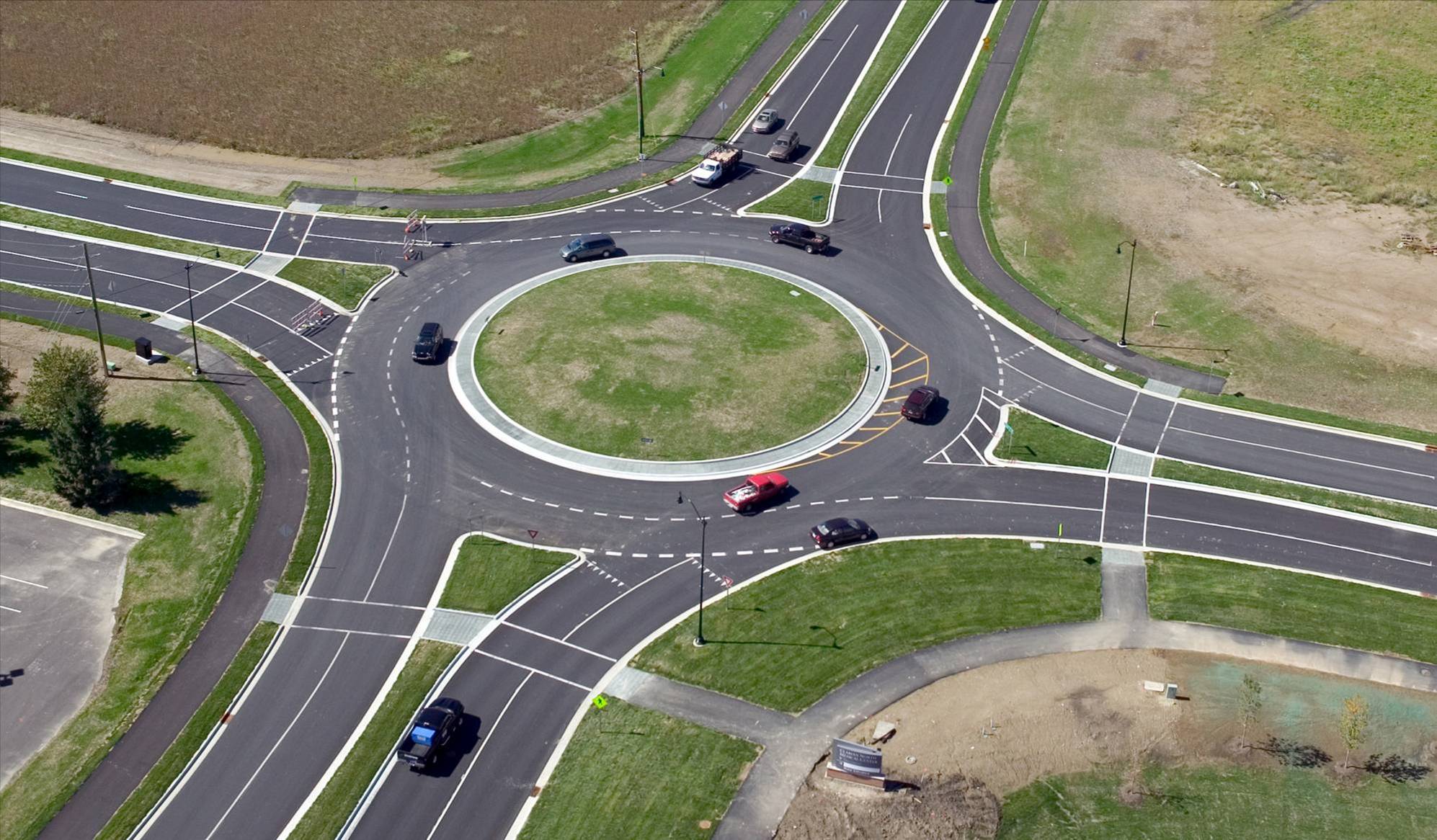 Class
42.5
Tuesday 1/17/17
Class
42.5
Tuesday 1/17/17Warm-Up :
A 1,000kg car drives in a counter-clockwise (when viewed from above) circle at a constant speed of 20m/s. If the circle's radius is 10m...
a. What is the car's acceleration? (magnitude and direction)
b. What is the net force acting on the car? (magnitude and direction)
Today:
- Exam Summary -- Numbers and types of questions and problems
- Work time
- Review packets:
- #5 -- Not a packet. Know the formulas for centripetal acceleration and centripetal force, and know how to apply them.
- #4
- #3
- #2
Homework:
- Tomorrow is our last chance to review. Bring any questions or problems that you would like to review.
- If you want to turn in your review packets for credit, turn them in with your exam and your formula sheet on exam day.
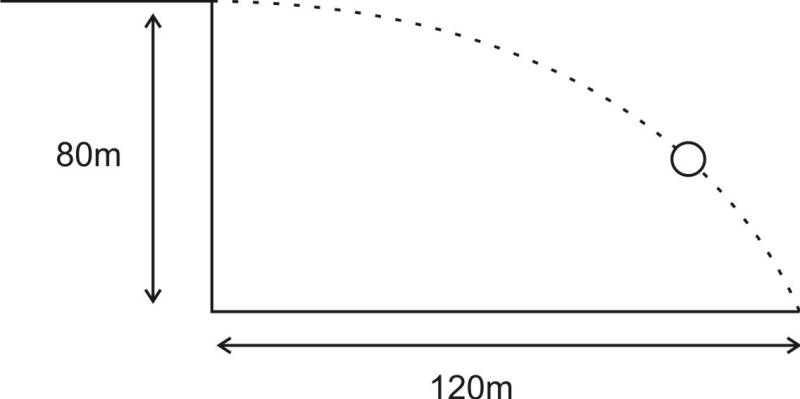
Warm-Up :
Assuming g=10m/s2, what was the initial speed of a horizontally-launched projectile that fell 80m and traveled 120m horizontally before hitting the ground?
Today:
- Revisit graphs -- see pink highlight, below
- Note -- In case you don't remember it, it would be a good idea to include the quadratic equation on your formula sheet.
- Review packets:
- #3-- New today
- #2
Homework:
-
Begin work on creating your own formula sheet for use on the
midterm. Formula sheet restrictions:
- Limited to 2 sides of one 8.5"x11" sheet of paper
- Handwritten
- If you use a formula sheet, it must be turned in with your exam
- Formulas only
- Exam review Packets:
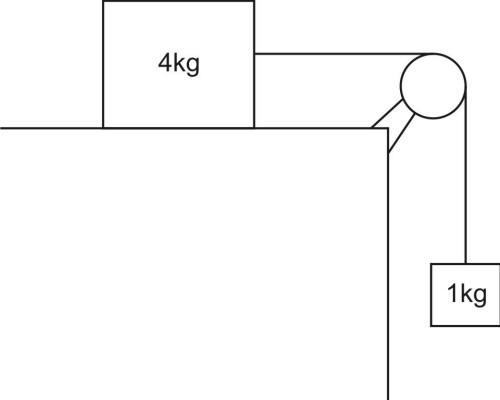 Class
41.5
Thursday 1/12/17
Class
41.5
Thursday 1/12/17Warm-Up :
There is friction between the 4kg mass and the surface. The 1kg mass is accelerating downward at a rate of 1m/s2.
If g=10m/s2, what is the tension in the string?
Today:
- Today's installment of the midterm review packets:
- Packet 1, from last class:
Homework:
-
Begin work on creating your own formula sheet for use on the
midterm. Formula sheet restrictions:
- Limited to 2 sides of one 8.5"x11" sheet of paper
- Handwritten
- If you use a formula sheet, it must be turned in with your exam
- Formulas only
-
Exam review Packets:
- Midterm Review Packet 1-- Kinematics (including Mr. Pennington's multiple choice and Mr. Chase's problems) Answers/solutions to Kinematics Packet
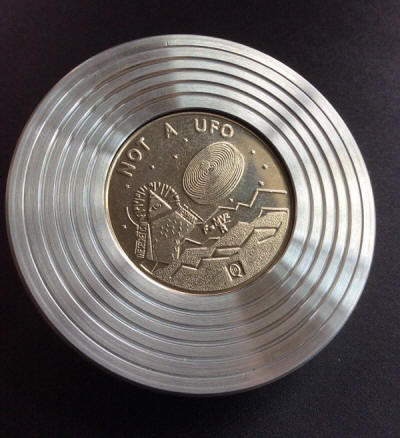 Class
41
Wednesday 1/11/17
Class
41
Wednesday 1/11/17Warm-Up :
Can anyone open the YOT? Please do not hit or force the YOT.
Today:
- Return Quizzes. Discuss the point value changes. Some students need to take the quiz.
- Go over homework.
- Work on Kinematics Review Packet
- Next class -- get forces review packet.
Homework:
-
Begin work on creating your own formula sheet for use on the
midterm. Formula sheet restrictions:
- Limited to 2 sides of one 8.5"x11" sheet of paper
- Handwritten
- If you use a formula sheet, it must be turned in with your exam
- Formulas only
- Midterm Review Packet 1-- Kinematics (including Mr. Pennington's multiple choice and Mr. Chase's problems) Answers/solutions to Kinematics Packet
Class at the rink
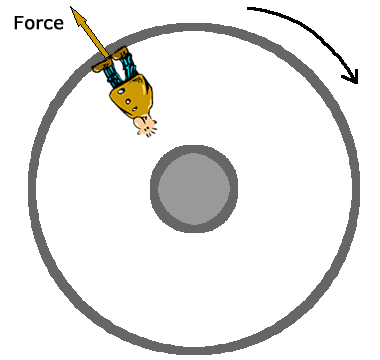 Class
40
Monday 1/9/17
Class
40
Monday 1/9/17Warm-Up :
Suppose we were in a circular space station roughly the size of this classroom (10m in diameter). How fast would the station need to rotate in order to simulate 1g at the outer edge? Answer in m/s (at the outer edge) and rpm.
Today:
- Quiz over momentum/impulse
- Circular Motion Problems #1 Answers Stapleton answers
- Circular Motion Problems #2 Answers
- Meet at the rink for class tomorrow.
Recommended Reading:
- Chapter 6.1 -- Rotation Angle and Angular Velocity
- Chapter 6.2 -- Centripetal Acceleration
- Chapter 6.3 -- Centripetal Force
Homework:
- Complete Circular Motion Problems #1 Answers
- If you one of these batteries, and you're willing to let us borrow it tomorrow, please bring it to the rink, fully charged: Dewalt 18V Black and Decker 18V
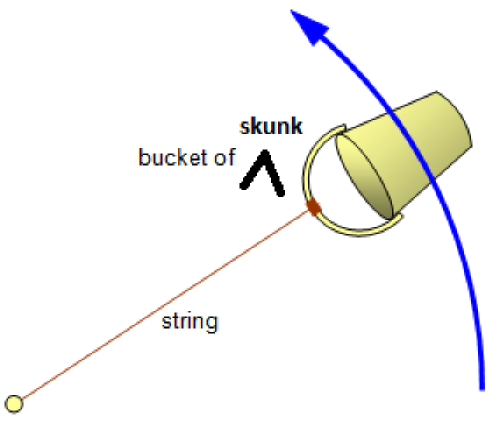 Class
39.5
Friday 1/6/17
Class
39.5
Friday 1/6/17Warm-Up :
A bucket containing a 1kg skunk is swung in a circle with a constant speed of 4m/s. The radius of the swing is 1m.
1. The skunk stays in the bucket, even at the top of the swing. Why?
2. What is the skunk's centripetal acceleration?
3. What force does the skunk feel at the top of the swing?
4. What force does the skunk feel at the bottom of the swing?
5. What happens to the skunk's weight as it orbits from top to bottom and back?
6. What happens to the net force acting on the skunk as the skunk orbits from top to bottom and back?
Today:
- Finish calculations from Circular Motion Notes and Stopper Activity. Turn them in.
- Quiz review? Momentum and Impulse Quiz Preview
- Circular Motion Problems #1
Recommended Reading:
- Chapter 6.1 -- Rotation Angle and Angular Velocity
- Chapter 6.2 -- Centripetal Acceleration
- Chapter 6.3 -- Centripetal Force
Homework:
- Read Chapter 6-6.3
- Prepare for quiz on Monday.
 Class
39
Thursday 1/5/17
Class
39
Thursday 1/5/17Warm-Up :
Renault Modus (compact car) vs. Volvo wagon in a head-on crash.
1. What happens?
2. Which is safer, a car that crumples in a crash or a car that is more rigid?
Today:
- Return old tests and corrections.
- Check/review homework.
- Momentum and Impulse Quiz Preview
- PowerPoint: Circular Motion and Gravitation
- Circular Motion Notes and Stopper Activity
Recommended Reading:
- Chapter 6.1 -- Rotation Angle and Angular Velocity
- Chapter 6.2 -- Centripetal Acceleration
- Chapter 6.3 -- Centripetal Force
Homework:
- Read Chapter 6-6.3
- Prepare for quiz on Monday.
 Class
38.5 Wednesday 1/4/17
Class
38.5 Wednesday 1/4/17Warm-Up :
1. What's interesting about a Newton's Cradle?
2. What concepts does a Newton's Cradle demonstrate?
3. What is the coefficient of restitution for a Newton's Cradle?
Today:
- Check/review homework.
- Momentum/Impulse PowerPoint
-
Updated End of Semester Plan:
- Thursday (1/5, A) -- review homework, quiz preview, begin gravity & circular motion
- Friday (1/6, B) -- Gravity& circular motion
- Monday (1/9, A) -- Momentum Quiz, Gravity& circular motion
- Tuesday (1/10, B) -- Finish Gravity& circular motion
- Wednesday (1/11) Through Tuesday (1/17) -- 5 Individual review packets. One per day. Final packet due on 1/17.
- Wed (1/18, A) -- Last review
Homework:
- Complete #1-11 in Momentum/Impulse Wrap-Up and Review Answers
 Class
38 Tuesday 1/3/17
Class
38 Tuesday 1/3/17Warm-Up :
In the system shown on the right, the effects of air resistance and string friction are negligible...
1. When is energy conserved? Why?
2. When is momentum conserved? Why?
Today:
- Quiz on Monday over Momentum and Impulse
- Return ballistic pendulum calculations
- Momentum/Impulse PowerPoint
- Work time
Homework:
- Use the coefficient of restitution formula to solve #4 and 5 on the last page of Notes: Momentum and Impulse Solution to #4 Link to Answers
- Complete the even numbered questions and problems in Practice with impulse and momentum Solutions
- Complete #12-14 in Momentum/Impulse Wrap-Up and Review answers to 12-14

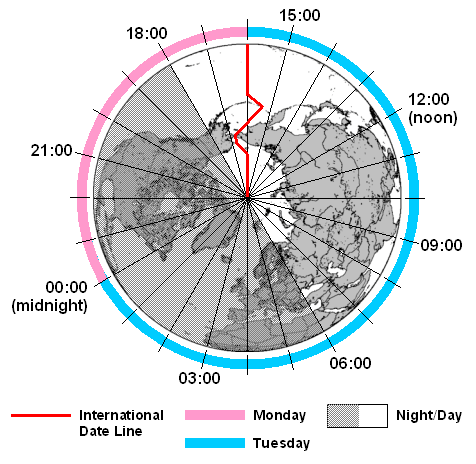 Class
37.5 Thursday 12/22/16
Class
37.5 Thursday 12/22/16Warm-Up :
Assuming that Santa must deliver all presents between 6PM on December 24th and 6AM on the 25th, for how many hours can he deliver presents? Should he generally travel an eastward or a westward route?
Today:
- Turn in one set of ballistic pendulum calculations for your group. Include all names.
- Santa Calculations
- Party -- toys etc.
- Virtual fireplace
Homework:
- None
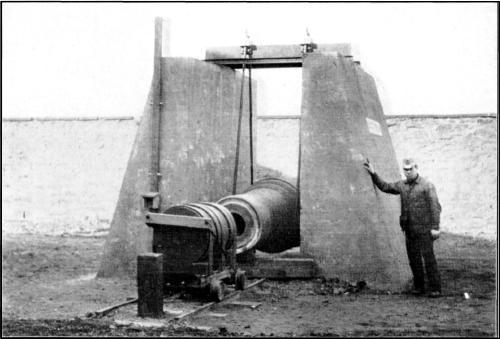 Class
37 Wednesday 12/21/16
Class
37 Wednesday 12/21/16Warm-Up :
Before radar guns, slow motion cameras, and accurate timers were invented, a cannon ball's muzzle velocity was calculated using a ballistic pendulum (or a similar contraption like the one on the right). A cannon ball of known mass was fired into a pendulum of known mass, where it embedded (got stuck) and caused the pendulum to swing to some height. From these two masses and the swing height the ball's velocity could be found.
1. Was the collision between the cannon ball and the pendulum elastic or inelastic?
2. What does that mean?
Today:
- Return old papers.
- Check/review homework.
- Shoot a sheet of paper into a ballistic pendulum. Measure the projectile's velocity. Ballistic Pendulum Handout
- Tomorrow's short class: Short analysis, Party? Games? Toys? Song?
Links: Read Chapter 8 Intro through 8.3 (conservation of momentum)
Homework:
- Finish ballistic pendulum calculations, if you didn't finish in class.
Warm-Up :
Suppose I stand a board on end and shoot it with a Nerf ® dart. Am I more likely to knock the board over if I use a dart that sticks to the board or if I use a dart that bounces off of the board?
Today:
- Check/review homework.
- Coefficient of Restitution
- Practice with impulse and momentum. Solutions.
Links: Read Chapter 8 Intro through 8.3 (conservation of momentum)
Homework:
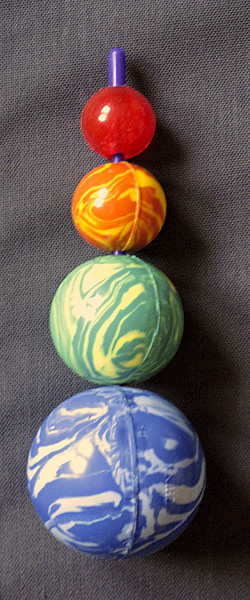 Class
36 Monday 12/19/16
Class
36 Monday 12/19/16Warm-Up :
The toy on the right is called an AstroBlaster. It consists of bouncy spheres threaded onto a rod. The whole contraption is dangled vertically and then dropped so that the large sphere hits the ground. What happens then? Why?
Today:
- Notes: Momentum and Impulse
Links: Read Chapter 8 Intro through 8.3 (conservation of momentum)
Homework:
- Finish "practice with conservation of momentum" 1-6, in Momentum and Impulse handout. Link to Answers
 Class 35.5 Friday 12/16/16
Class 35.5 Friday 12/16/16
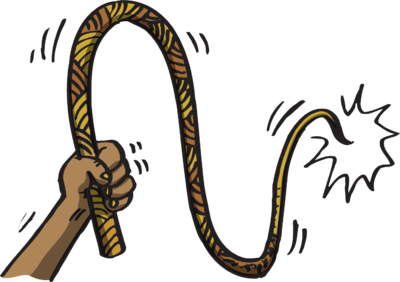 Warm-Up
:
Warm-Up
:
1. How does a whip work?
2. How can a towel be like a whip?
Today:
- Return Tests
- Learn to tie a Trucker's Hitch and explain its merits. How fast can you tie it?
Homework:
- Read Chapter 8 Intro through 8.1. The chapter 8 focus is momentum.
Warm-Up :
No warm-up today.
Today:
-
I need to know all of the students where in these egg bungee groups,
so that I can award extra points:
- 1st Place: Sam Feehan: 0cm.
- 2nd Place: Dakota Allen: 1cm
- 3rd Place: Connor Charland: 1.5cm*
- Test
- Learn to tie a Trucker's Hitch.
Homework:
- Read Chapter 8 Intro through 8.1. The chapter 8 focus is momentum.
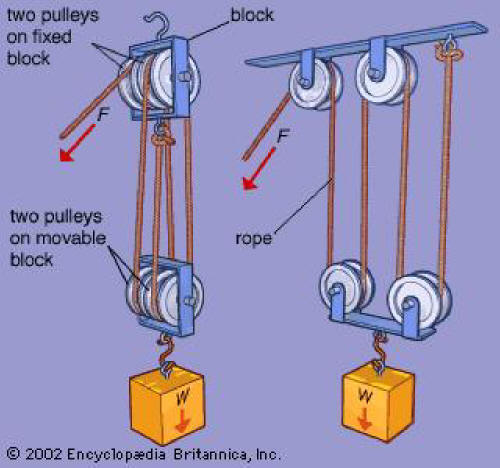 Class 34.5 Wednesday 12/13/16
Class 34.5 Wednesday 12/13/16Warm-Up :
In either case on the right, if the weight is 10N, how much force must be applied to rope to lift the weight? Why? (Ignore the masses of the pulleys and rope, and assume 100% efficiency.)
Today:
- Check/discuss Test Review: Work and Energy (Solutions)
Homework:
- Study. Test tomorrow.
 Class 34 Tuesday 12/13/16
Class 34 Tuesday 12/13/16Warm-Up :
Two identical springs have a spring constant k = 100N/m. The two springs can be arranged in series (Fig. A) or parallel (Fig. B). If a 10N weight is added to the end springs, released, and allowed to come to rest...
1. How far would the weight stretch one of the springs alone?
2. How far would the weight stretch the two springs arranged in series?
3. How far would the weight stretch the two springs in parallel?
4. What single spring constant could be used for the assembly of springs in series? How about the parallel springs?
Today:
Homework:
- Complete test review.

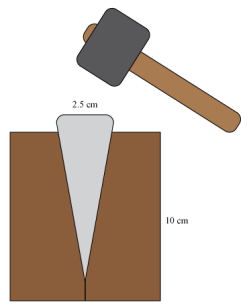

Warm-Up :
The pictures on the right all show simple machines. Simple machines change the nature of work to help people accomplish tasks. W = Fd.
1. Identify the task in each picture.
2. For each picture, identify the machine (s).
3. For each machine, tell how the machine alters the distance over which force must be applied by the human using the machine.
4. How does the machine alter the force that the human must apply?
Today:
- Check/review homework: Spring Energy and Some Review (solutions)
Homework:
-
We will have a quiz on Thursday over work and energy. The
quiz will cover problems similar to those in the problem sets below.
What sort of additional practice would you like? Review the
problems below and identify any problems that you would like to
practice tomorrow. Then
fill out this form indicating your preference.
- Review these problems:
- Energy and Work -- practice problems 1-6 (Answers)
- Bungee jump homework problem. (solution)
- Spring Energy and Some Review (solutions).
- Review these problems:
 Class 33 Friday 12/9/16
Class 33 Friday 12/9/16 Warm-Up :
In problem 3 of last night's homework, a 50g object was attached to the bottom of a spring and released. After bobbing up and down for a bit, the object came to rest 20cm below its original position. Problem 3.b. asked for the spring constant. Which of the solutions below is correct? Why?
Solution #1:
PEspring = PElost by object = mgh = (0.05kg)(9.8m/s2)(0.2m) = 0.098J
PEspring=1/2 kx2, so 0.098J = 0.5(k)(0.2)2. Thus k = 4.9N/m
Solution #2:
Weight of object = Fspring = kx. So, mg = kx or (0.05kg)(9.8m/s2) = k(0.2m). Thus k = 2.45N/m
Today:
- Check/review homework
-
A7/8:
Finish
Bungee Jump Activity
(spreadsheet
template)
- 200g bungee jump
- Time for more calculations
- Egg jump
- Turn it in however you want -- share online or hard copy (printed graphs).
- Homework
- In small groups, experiment with the Phet Skate Park Simulation. Group Questions.
- Finish Spring Energy and Some Review (solutions)
Online Textbook (OpenStax) Reading:
Homework:
Warm-Up :
Suppose a screen door spring has a spring constant k = 40N/m.
1. What maximum force is required to stretch the spring a distance of 1m?
2. Why was the word "maximum" added to the previous question?
3. What force is required to stretch the spring a distance of 20cm?
4. How much work is required to stretch the spring a distance of 1m?
5. How much work is required to stretch a spring x meters if its spring constant is k?
6. How much potential energy is stored in that spring?
Today:
- Review homework. Check (unless online)
-
Finish
Bungee Jump Activity
(spreadsheet
template)
- 200g bungee jump
- Time for more calculations
- Egg jump
- Turn it in however you want -- share online or hard copy (printed graphs).
- Homework
- Rocket Standings
- Spring Energy and Some Review
Online Textbook (OpenStax) Reading:
Links: Experiment with the Phet Skate Park Simulation. Experiment with different graphs, friction, locations, and positions. Build new tracks. Does heat only appear when you enable friction?
Homework:
- Complete #1-6 of Spring Energy and Some Review
Warm-Up : No warm-up today
Today:
- Discuss Rocket Project Grading.
-
Finish
Bungee Jump Activity
(spreadsheet
template)
- 200g bungee jump
- Time for more calculations
- Egg jump
- Turn it in however you want -- share online or hard copy (printed graphs).
- Homework
- Rocket Standings
- Spring Energy and Some Review
Online Textbook (OpenStax) Reading:
Links: Experiment with the Phet Skate Park Simulation. Experiment with different graphs, friction, locations, and positions. Build new tracks. Does heat only appear when you enable friction?
Homework:
- Due on Thursday: Bungee jump homework problem. Estimate a spring constant for the bungee. Create force and energy graphs. Determine the distance fallen when the dropped 150g object reaches its low point. Turn in a hard copy or share your document. If you share the document, include the answers in a note or email.
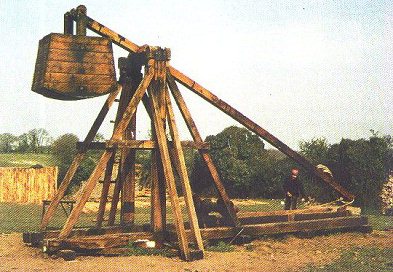 Class
31.5 Tuesday 12/6/16
Class
31.5 Tuesday 12/6/16 Warm-Up :
A trebuchet is powered by a 500kg mass that falls a distance of 3m. If the trebuchet fires a 5kg bowling ball with 50% efficiency, what velocity will the bowling ball have when it leaves the trebuchet?
What is "% efficiency?"
Today:
- Finish Bungee Jump Activity (spreadsheet template)
- Bungee jump?? Eggs next class.
- Rocket Standings
Online Textbook (OpenStax) Reading:
Links: Experiment with the Phet Skate Park Simulation. Experiment with different graphs, friction, locations, and positions. Build new tracks. Does heat only appear when you enable friction?
Homework:
- Due on Thursday: Bungee jump homework problem. Estimate a spring constant for the bungee. Create force and energy graphs. Determine the distance fallen when the dropped 150g object will reach its low point. Turn in a hard copy or share your document. If you share the document, include the answers in a note or email.
 Class
31 Monday 12/5/16
Class
31 Monday 12/5/16
 Warm-Up
:
Warm-Up
:
Calculate the work done according to each of the graphs.
Today:
- Bungee Jump Activity (spreadsheet example)
- Get your rocket analysis in today in order to be considered for the contest.
Online Textbook (OpenStax) Reading:
Links: Experiment with the Phet Skate Park Simulation. Experiment with different graphs, friction, locations, and positions. Build new tracks. Does heat only appear when you enable friction?
Homework:
- Finish Bungee Jump Activity
 Class 30.5 Friday 12/2/16
Class 30.5 Friday 12/2/16 Warm-Up :
What do you see when you suspend a Slinky, let it gravity stretch it out, release it, and capture the footage in slow motion? Why?
Today:
- Check/Review Homework: Energy and Work practice questions
- Experiment with the Phet Skate Park Simulation. Experiment with different graphs, friction, locations, and positions. Build new tracks. Does heat only appear when you enable friction?
Online Textbook (OpenStax) Reading:
Links:
-
Water Rocket Simulator. There are others available online. If you use it, enter 90psi air pressure as "90p"
Homework:
- Complete the "work and energy practice problems" in Energy and Work
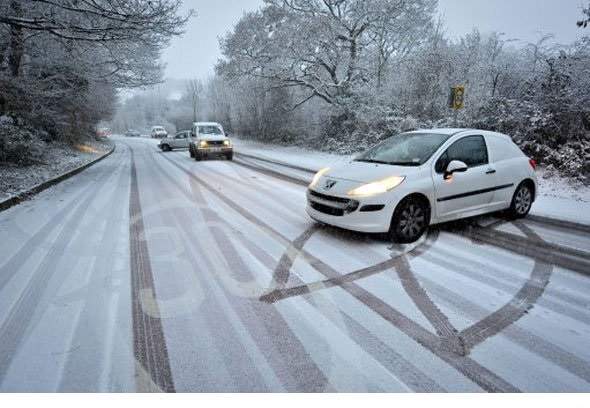 Class
30 Thursday 12/1/16
Class
30 Thursday 12/1/16 Warm-Up :
If you need to stop a car quickly, why shouldn't you slam on the brakes and "lock" the tires? Why is it better to apply gentle pressure or pump the brakes? The same reasoning applies when you are simply trying to stop normally on a slick surface, such as ice.
Today:
Online Textbook (OpenStax) Reading:
Links:
-
Water Rocket Simulator. There are others available online. If you use it, enter 90psi air pressure as "90p"
Homework:
- Turnin your water rocket analysis and share your completed spreadsheet as soon as you can. I won't take points off for lateness, but you won't have a grade until you get it in.
- Complete the "work and energy practice problems" in Energy and Work
 Class
29.5 Wednesday 11/30/16
Class
29.5 Wednesday 11/30/16 Warm-Up :
How are g-forces dangerous to pilots?
Today:
-
Fix/finish the Water Rocket Analysis -- videos are in the student drive
-
Spreadsheet stuff
-
For a screenshot of working spreadsheet, click the thumbnail.
Online Textbook (OpenStax) Reading:
Links:
-
Water Rocket Simulator. There are others available online. If you use it, enter 90psi air pressure as "90p"
Homework:
- Complete the Water Rocket Analysis by Tomorrow.
- Complete and share the drag spreadsheet with Mr. Stapleton.
- Read Chapter 7 introduction, section 7.1, and section 7.2.

 Class
29 Tuesday 11/29/16
Class
29 Tuesday 11/29/16 Warm-Up :
The circled data on the right correspond to the bottom two data points in the photograph.
1. Which data are incorrect; the time data, the position data or the velocity data? How do you know? Why are they incorrect?
2. What is the best way to calculate the rocket's acceleration during this phase?
3. Is Logger Pro rounding the time data?
Today:
-
Water Rocket Analysis -- videos are in the student drive
-
Spreadsheet stuff
-
For a screenshot of working spreadsheet, click the thumbnail.
Online Textbook (OpenStax) Reading:
Links:
-
Water Rocket Simulator. There are others available online. If you use it, enter 90psi air pressure as "90p"
Homework:
- Complete the Water Rocket Analysis by Thursday.
- Read Chapter 7 introduction, section 7.1, and section 7.2.
 Class
28.5 Monday 11/28/16
Class
28.5 Monday 11/28/16 Warm-Up :
How many 100 psi water bottles would it take to launch a human?
Today:
-
Water Rocket Analysis -- videos are in the student drive
-
Spreadsheet stuff
-
For a screenshot of working spreadsheet, click the thumbnail.
Online Textbook (OpenStax) Reading:
Links:
-
Water Rocket Simulator. There are others available online. If you use it, enter 90psi air pressure as "90p"
Homework: Complete the Water Rocket Analysis by Wednesday.
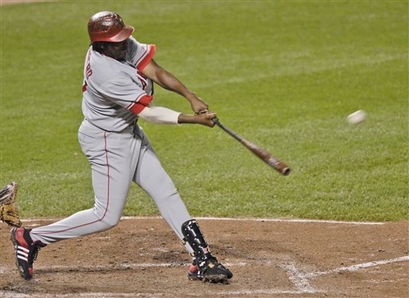 Class
28 Friday 11/18/16
Class
28 Friday 11/18/16 Warm-Up :
1. What is the best launch angle for a home run in baseball?
2. What are the variables that affect the answer to the previous question?
Baseball Trajectory, with drag
Today:
-
Prepare your rocket (s)
-
Measure and record empty mass.
-
Measure and record added water volume.
-
Measure/estimate and record your rocket's cross-sectional area in m2.
-
-
Launch Rockets
Online Textbook (OpenStax) Reading:
Links:
-
Water Rocket Simulator. There are others available online. If you use it, enter 90psi air pressure as "90p"
Homework:
- Prepare for tomorrow. We will launch rockets and then begin data analysis. We will be pressurizing rockets to 100psi.
 Class
27.5 Thursday 11/17/16
Class
27.5 Thursday 11/17/16 Warm-Up :
A ping-pong ball has a mass of 2.7g, a radius of 2cm, and a drag coefficient of 0.5. If the density of the surrounding air is 1.2kg/m3, what is the ping-pong ball's terminal velocity?
Drag = 0.5*Cd*ρ*A*V2
Today:
-
5/6 class -- watch a launch video
-
Work on rockets -- Final launch tomorrow. Pressurizing to 100psi.
-
Begin spreadsheets.
-
For a screenshot of working spreadsheet, click the thumbnail.
Online Textbook (OpenStax) Reading:
Links:
-
Water Rocket Simulator. There are others available online. If you use it, enter 90psi air pressure as "90p"
Homework:
- Prepare for tomorrow. We will launch rockets and then begin data analysis. We will be pressurizing rockets to 100psi.
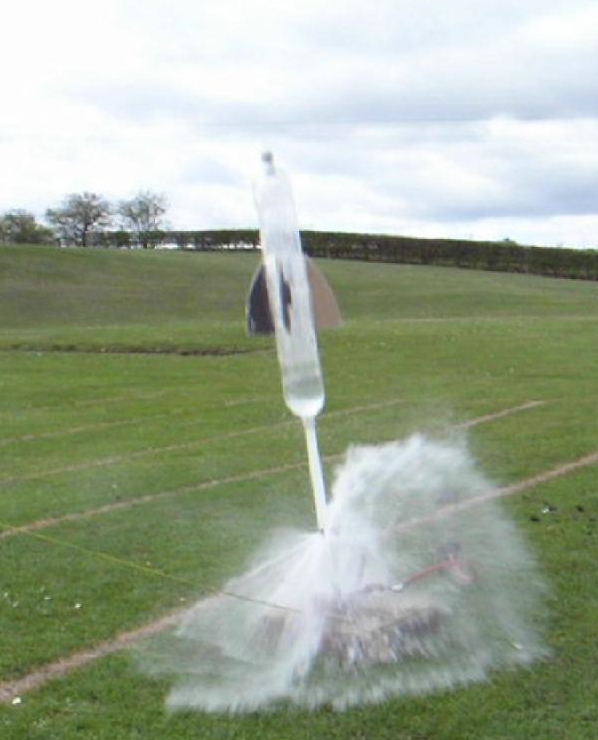 Class
27 Wednesday 11/16/16
Class
27 Wednesday 11/16/16 Warm-Up : Regarding a water rocket's design and launch conditions...
1. Why is it bad to have too much weight?
2. Why is it bad to have too little weight?
3. Why is it bad to have too much water?
4. Why is it bad to have too little water?
5. Assuming that your rocket is already stable in flight, how can you make it go higher?
Today:
-
Preview Data Collection
-
Work on rockets
-
Begin spreadsheets
-
For a screenshot of working spreadsheet, click the thumbnail.
-
Coming Up:
-
Tomorrow: Finish rockets.
-
Friday: Final launch
-
Online Textbook (OpenStax) Reading:
Links:
-
Water Rocket Simulator. There are others available online. If you use it, enter 90psi air pressure as "90p"
Homework:
- If you want to get ahead, work on the drag spreadsheet.
Warm-Up :
No warm-up today. Get your rocket ready. Clean up when you're done.
Today:
-
Rocket Launch
Online Textbook (OpenStax) Reading:
Links:
-
Water Rocket Simulator There are others available online. This happens to be the first that I saw. If you use it, enter 90psi air pressure as "90p"
Homework:
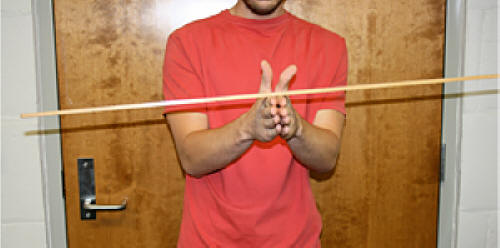 Class
25 Monday 11/14/16
Class
25 Monday 11/14/16 Warm-Up :
One way to find the center of mass of a stick is to support it with two level hands and then slowly move those two hands together until they meet under the stick's center of mass.
Why does this method work?
Today:
-
Quiz -- Newton's Laws in 2D
-
Build Rockets. We will launch twice. We can do it tomorrow and on Friday, or we can launch on Wednesday and Friday. What is your preference?
Online Textbook (OpenStax) Reading:
Links:
-
Water Rocket Simulator There are others available online. This happens to be the first that I saw. If you use it, enter 90psi air pressure as "90p"
Homework:
- Do you need to do any outside-of-class work related to your rocket?
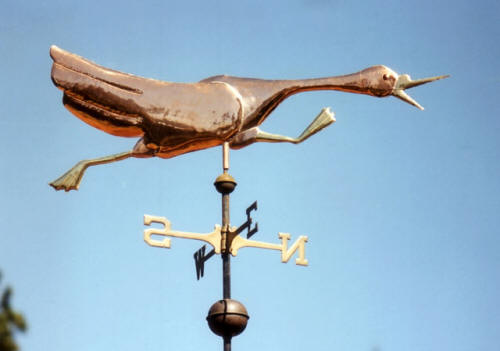 Class
24.5 Friday 11/11/16
Class
24.5 Friday 11/11/16 Warm-Up :
1. How does a weather vane work?
2. How are good rockets like weather vanes?
3. The paper rocket on the right can be made even more stable by adding
mass to the right part of the rocket. Where should extra mass be
added, and why?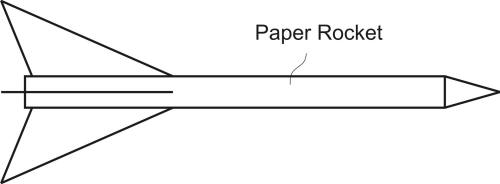
Today:
-
Build water rockets
Online Textbook (OpenStax) Reading:
Links:
-
Water Rocket Simulator There are others available online. This happens to be the first that I saw. If you use it, enter 90psi air pressure as "90p"
Homework:
- Prepare for quiz on Monday.
 Class
24 Thursday, 11/10/16
Class
24 Thursday, 11/10/16 Warm-Up :
Sometimes people celebrate special occasions by firing guns into the air.
1. Is this ever a good way to celebrate? Explain.
2. What factors do you think might affect the force of drag (air resistance) on a bullet?
3. What factors influence the terminal velocity of a bullet?
Calculated terminal velocities of various spheres.
Today:
-
Water rocket Project
-
Paper rockets. Experiment with fins and weight to make a paper rocket that flies as far as possible.
Online Textbook (OpenStax) Reading:
-
4.5 Normal, Tension, and Other Examples of Forces
-
4.6 Problem-Solving Strategies
-
4.7 Further Applications of Newton’s Laws of Motion
Links:
-
Water Rocket Simulator There are others available online. This happens to be the first that I saw. If you use it, enter 90psi air pressure as "90p"
Homework:
- Prepare for quiz on Monday.
Warm-Up :
"Fearless" Felix Baumgartner became the first human to break the sound barrier without traveling in a vehicle. How did he do it?
Today:
-
Check / review Statics Problems. Solutions
Online Textbook (OpenStax) Reading:
-
4.5 Normal, Tension, and Other Examples of Forces
-
4.6 Problem-Solving Strategies
-
4.7 Further Applications of Newton’s Laws of Motion
Homework:
- Finish the practice quiz.
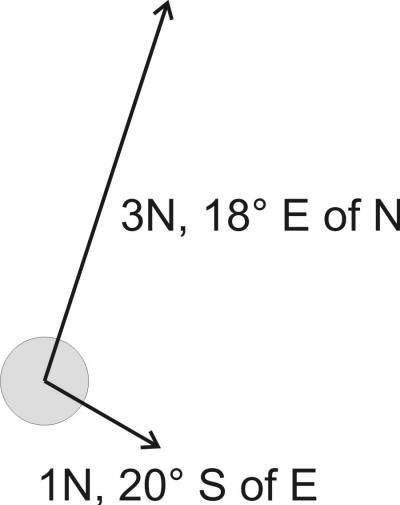 Class
23 Monday, 11/7/16
Class
23 Monday, 11/7/16 Warm-Up :
The object on the right is being acted upon by 2 forces. What third force would stop the object's acceleration and thereby introduce a state of dynamic equilibrium?
1. How can you find the necessary force graphically?
2. How can you find the necessary force numerically?
Today:
-
Check/review homework from past two classes.
-
Test corrections will be graded and entered before the grading deadline on Wednesday.
-
If you haven't turned in your Newton Sled experiment, turn it in.
Online Textbook (OpenStax) Reading:
-
4.5 Normal, Tension, and Other Examples of Forces
-
4.6 Problem-Solving Strategies
-
4.7 Further Applications of Newton’s Laws of Motion
Homework:
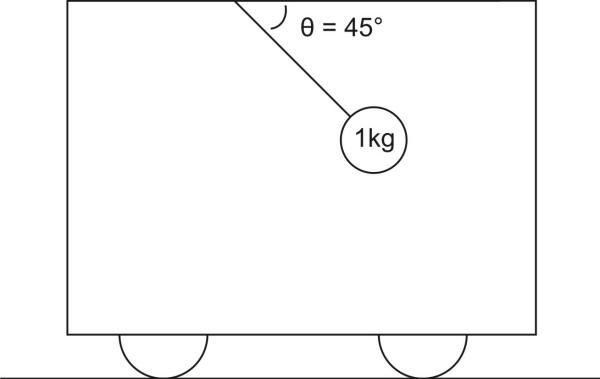 Warm-Up
:
Warm-Up
:
A 1kg mass is suspended by a string from the ceiling of a train car. The angle shown remains constant.
1. Describe the motion of the mass.
2. What is the tension in the string?
3. What determines an obect's terminal velocity?
Today:
-
Check/review homework.
-
Finish your Newton Sled Experiment and turn in one for your group. When you enter calculations for the launch of the Earth, use only the sled rubber band force (instead of the average).
Online Textbook (OpenStax) Reading:
-
4.5 Normal, Tension, and Other Examples of Forces
-
4.6 Problem-Solving Strategies
-
4.7 Further Applications of Newton’s Laws of Motion
Homework:
- Suppose the angle in the warm-up, above, is 30º and the mass is 3kg. In this case, what is the train's acceleration? What is the tension in the string?
 Class
22 Thursday, 11/3/16
Class
22 Thursday, 11/3/16 Warm-Up :
Why doesn't the arch fall? In particular, why doesn't the red keystone fall? What forces are acting on it?
Today:
-
Due to increased end-of-quarter demand, you can turn in your test corrections to Mr. Stapleton. For credit, show all work and explanations on separate paper. Staple the corrections to the front of your test.
-
Newton's Laws + Trig. Bodies on Inclines practice problem (s).
Online Textbook (OpenStax) Reading:
-
4.5 Normal, Tension, and Other Examples of Forces
-
4.6 Problem-Solving Strategies
-
4.7 Further Applications of Newton’s Laws of Motion
Homework:
- Finish the Bodies on Inclines problems. Answers
 Class 21.5 Wednesday, 11/2/16
Class 21.5 Wednesday, 11/2/16 Warm-Up :
The picture on the right shows how a chain can be used to pull a stuck car out of the mud. All that is required is a small sideways force applied to the center of the chain. Why does this work?
Today:
Online Textbook (OpenStax) Reading:
-
4.5 Normal, Tension, and Other Examples of Forces
-
4.6 Problem-Solving Strategies
-
4.7 Further Applications of Newton’s Laws of Motion
Homework:
- None. If you're doing test corrections, do as much of the correct as you can on your own. Then ask a friend or classmate. The point is really for you to do your own correcting, so only ask Mr. Stapleton for help when you're out of other options.
Warm-Up :
No Warm up
Today: Test
Online Textbook (OpenStax) Reading:
-
4.5 Normal, Tension, and Other Examples of Forces
-
4.6 Problem-Solving Strategies
-
4.7 Further Applications of Newton’s Laws of Motion
Homework:
- If you have not completed the Newton Sled spreadsheet, finish it.
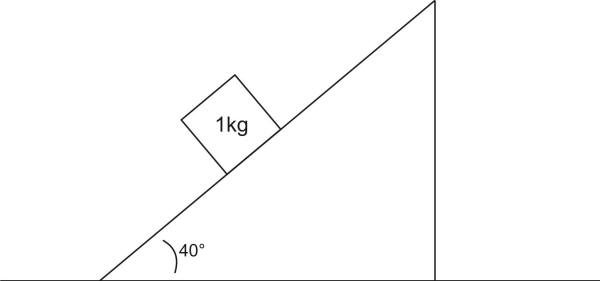 Class
20.5 Monday, 10/31/16
Class
20.5 Monday, 10/31/16 Warm-Up :
1. If there is no friction acting on the block, what is its downhill acceleration?
2. What µs is necessary to prevent the block from sliding?
Today:
- Questions about Multibody Drill A? Mr. Chase solutions Mr. Stapleton solutions)
- Practice Test Answers but not solutions Problem Solutions
Online Textbook (OpenStax) Reading:
-
4.5 Normal, Tension, and Other Examples of Forces
-
4.6 Problem-Solving Strategies
-
4.7 Further Applications of Newton’s Laws of Motion
Homework:
- Prepare for tomorrow's Test.
- Some time before Thursday, finish the Newton Sled Experiment handout.
Warm-Up :
If we put a big rock on someone's head, can we place a 2"x4" on the rock and then hammer a nail into the 2"x4"? Is it a good idea?
Today:
- Questions about Multibody Drill A? Mr. Chase solutions Mr. Stapleton solutions)
- Practice Test Answers but not solutions Problem Solutions
Online Textbook (OpenStax) Reading:
Homework:
- Prepare for Tuesday's test. Fihish the practice test.
- Some time before next Thursday, finish the Newton Sled Experiment handout.
Warm-Up :
Provide SI units and other units for each of these quantities
| Quantity | SI Units | Other Units |
| mass | ||
| velocity | ||
| weight | ||
| time | ||
| distance | ||
| force | ||
| acceleration | ||
| friction |
Today:
- (20 min) Check/review homework. (Multibody Drill A Mr. Chase solutions Mr. Stapleton solutions)
- Work on the Newton Sled Experiment handout.
- Tomorrow -- Practice test / test review. Final review on Monday. Test on Tuesday.
Online Textbook (OpenStax) Reading:
-
4.5 Normal, Tension, and Other Examples of Forces
-
4.6 Problem-Solving Strategies
-
4.7 Further Applications of Newton’s Laws of Motion
Homework: Due by the beginning of class tomorrow...
- If you missed problems on the Multibody Drill A, watch the corresponding video on Mr. Stapleton's YouTube channel. If you still have questions, be prepared to ask them tomorrow. PDF solutions --Multibody Drill A solutions -- Stapleton
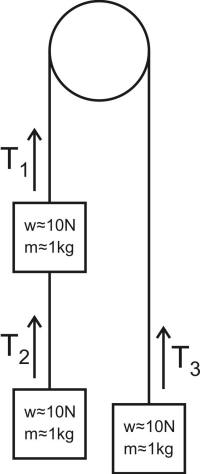 Class
19 Wednesday, 10/26/16
Class
19 Wednesday, 10/26/16 Warm-Up : The figure on the right shows some masses connected by an unstretchable chain of negligible mass that travels over a frictionless, massless pulley in a vacuum. Assume that each object has a mass of approximately 1kg and a weight of approximately10N.
1. What net force is acting on the system of objects?
2. What are the objects' accelerations? (magnitude and direction)
3. How do the rope tensions, T1, T2, and T3 compare? Rank them according to magnitude.
Today:
- (20 min) Check/review homework assignned last Tuesday [#38, 44, and 47 in Practice with forces in 1 dimension Answers/solutions Mr. S. Solutions]
- (15 min) Multibody Drill A practice problem
- Finish Newton Sled Activity by next class.
- Newton Sled Calculations Spreadsheet VIDEO INSTRUCTIONS LINK-- share with Mr. Stapleton before next class.
- At this point, if you're missing data, you can use another group's data.
- Tomorrow: finish the Newton Sled Experiment handout.
Online Textbook (OpenStax) Reading:
-
4.5 Normal, Tension, and Other Examples of Forces
-
4.6 Problem-Solving Strategies
-
4.7 Further Applications of Newton’s Laws of Motion
Homework: Due by the beginning of class tomorrow...
- Finish the Newton Sled Spreadsheet. Individually or as a group, share it with Mr. Stapleton. If you're working as a group, include the names of the students who should get credit.
- Multibody Drill A Mr. Chase solutions Mr. Stapleton solutions
 Class
18.5 Tuesday, 10/25/16
Class
18.5 Tuesday, 10/25/16 Warm-Up :
Each of the people standing in the bus is holding a rail or a handle.
1. As the bus starts moving forward, in which direction will the people exert force on the bus? Why?
2. What about when the bus comes to a stop?
Today:
- Questions? How did the lab go?
-
Finish Newton Sled Activity.
- Today:
- Newton Sled Calculations Spreadsheet -- share with Mr. Stapleton before next class.
- Finish data collection (if necessary).
- Tomorrow: finish the Newton Sled Experiment handout.
- Today:
- Test coming up. Probably next Tuesday.
Online Textbook (OpenStax) Reading:
-
4.5 Normal, Tension, and Other Examples of Forces
-
4.6 Problem-Solving Strategies
-
4.7 Further Applications of Newton’s Laws of Motion
Homework: Due by the beginning of class tomorrow...
- Get some rest. You will have a lot of work to do later, but not tonight.
Warm-Up :
Watch these instructional videos. The total length is about 17 minutes.
- "Stretch Distance" Correction -- Watch this one first. I was watching the other videos and realized that I had been measuring this incorrectly.
- Newton Sled Overview
- Finding Newton Sled Coefficient of Friction
- Newton Sleds -- One more thing
Today:
- Watch the Newton Sled Video Instructions, above.
- Form a group of 3 people or fewer.
- Get a copy of the Newton Sled Directions. You can read these as you work. They take you through the steps below.
- Collect Data
- Slide the sled to get kinetic friction coefficient data
- Launch and collect distance and mass data.
- Make a copy of this spreadsheet template. Then enter formulas until your spreadsheet works like the one shown in step 6, below.
- Check your spreadsheet answers with
this screen shot.
- Find rubber band forces by entering data into your spreadsheet.
- If you don't have one already, get the Newton Sled Experiment handout. Fill out one per group.
- What to turn in (due by the beginning of class on Wednesday):
- Completed Newton Sled Experiment handout.
- Newton Sled Calculations Spreadsheet -- share with Mr. Stapleton.
Online Textbook (OpenStax) Reading:
- Ch 4: Newton's Laws Intro
- Ch 4.1: Force
- Ch 4.2: Newton's 1st Law, Inertia
- Ch 4.3: Newton's 2nd Law, Concept of a System
- Ch 4.4: Newton's 3rd Law, Symmetry in Forces
Homework: IF you haven't already finished the homework for last class, complete it.
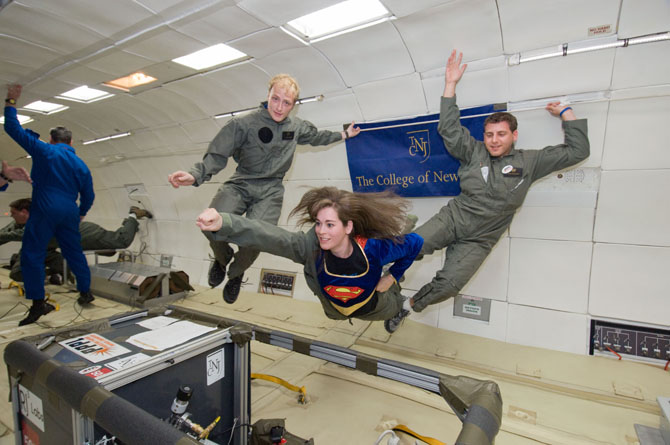 Class
17.5 Tuesday, 10/18/16
Class
17.5 Tuesday, 10/18/16 Warm-Up :
1. How does NASA simulate weightlessness?
2. You are trying to transfer some drippy sauce across a dinner table using only a drippy spoon. The sauce needs to go from the pot to your plate without dripping. Touching only the spoon, how can you make this happen?
Today:
- Check/review homework problem #37. Solution to #37.
- Complete #38, 44, and 47 in Practice with forces in 1 dimension Answers/solutions Mr. S. Solutions
- Mr. Stapleton gone on Monday. On Monday, complete sled experiment and calculations.
Online Textbook (OpenStax) Reading:
- Ch 4: Newton's Laws Intro
- Ch 4.1: Force
- Ch 4.2: Newton's 1st Law, Inertia
- Ch 4.3: Newton's 2nd Law, Concept of a System
- Ch 4.4: Newton's 3rd Law, Symmetry in Forces
Homework: Complete #38, 44, and 47 in Practice with forces in 1 dimension Answers/solutions Mr. S. Solutions
Warm-Up :
A 500g mass (circled in red) is going to be launched by rubber bands (yellow highlight) that are stretched between upright screws (blue) and string (green). Release is accomplished by the burning of the string. The mass and the launcher are both pendulums. What will happen when the string is burned?
Video Link to 500g Newton Sled Launch
Today:
- Launcher Project Grade reminder: If you are missing any portion of the projectile launcher project in PowerSchool, either hand in what's missing or share with me the completed spreadsheet (even if you shared it with me earlier, before you had finished all of it). I will be adding weights to the grades in the next day or two.
- Check/review homework. Answers/solutions
- Newton Sled Experiment
- Mr. Chase Ch 4 PowerPoint
Online Textbook (OpenStax) Reading:
- Ch 4: Newton's Laws Intro
- Ch 4.1: Force
- Ch 4.2: Newton's 1st Law, Inertia
- Ch 4.3: Newton's 2nd Law, Concept of a System
- Ch 4.4: Newton's 3rd Law, Symmetry in Forces
Homework: If you didn't understand the last homework problem that was due today, try it again tonight.
 Class 16.5 Friday, 10/14/16
Class 16.5 Friday, 10/14/16 Warm-Up :
1. How can the unfortunate character get to the oxygen tank before running out of oxygen?
2. What is Newton's 3rd Law? Can you think of an exception to this law?
3. What is a coefficient of friction (µ) and how does µk (for kinetic friction) differ from µs (for static friction)?
Today:
- Check/review homework. Answers
- Mr. Chase Ch 4 PowerPoint
- Handout: Practice with forces in 1 dimension Answers/solutions
Online Textbook (OpenStax) Reading:
- Ch 4: Newton's Laws Intro
- Ch 4.1: Force
- Ch 4.2: Newton's 1st Law, Inertia
- Ch 4.3: Newton's 2nd Law, Concept of a System
- Ch 4.4: Newton's 3rd Law, Symmetry in Forces
Homework: Don't answer question 9 or complete problems 4, 13, 14, 38, 44, and 47, in "Practice with forces in 1 dimension Answers/solutions," but do complete the rest.
Warm-Up :
There is a heavy object tied to the ceiling with a string. Another segment of the from the same roll of string is hanging from the object. I am going to pull on the bottom string until one of the two strings breaks. Which string is going to break first? Why?
Today:
- Check/review homework. Answers
- Project -- who has turned in what.
- Complete the rest of the practice problems.
- Mr. Chase Ch 4 PowerPoint
- Handout: Newton's 1st and 2nd Laws
- Handout: Practice with forces in 1 dimension Answers/solutions
Online Textbook (OpenStax) Reading:
- Ch 4: Newton's Laws Intro
- Ch 4.1: Force
- Ch 4.2: Newton's 1st Law, Inertia
- Ch 4.3: Newton's 2nd Law, Concept of a System
- Ch 4.4: Newton's 3rd Law, Symmetry in Forces
Homework: Complete the last two "More Practice: Newton's 1st and 2nd Laws" problems in this handout -- Handout: Newton's 1st and 2nd Laws
 Class
15.5 Wednesday, 10/11/16
Class
15.5 Wednesday, 10/11/16 Warm-Up :
It is possible to pull the paper from under a dry erase pen without touching or tipping the pen. Usually, however, the pen falls over. Why does the pen usually fall? How can one do this without tipping the pen? Why does that method work (sometimes)?
Today:
- Results of the projectile contest Contest Data.
- Due to the frenzied contest atmosphere, the contest problem solutions will not be graded. Recycle or keep them; it's up to you.
- If you haven't turned in your practice problem solutions or your completed (all three tabs) spreadsheet, you can still do that today. There wasn't much time for turning things, or for me to remind you to turn things in, during yesterday's class.
- Mr. Chase Ch 4 PowerPoint
- Handout: Newton's 1st and 2nd Laws
Online Textbook (OpenStax) Reading:
- Ch 4: Newton's Laws Intro
- Ch 4.1: Force
- Ch 4.2: Newton's 1st Law, Inertia
- Ch 4.3: Newton's 2nd Law, Concept of a System
- Ch 4.4: Newton's 3rd Law, Symmetry in Forces
Homework: Complete #1-10 of "More Practice: Newton's 1st and 2nd Laws" in this handout -- Handout: Newton's 1st and 2nd Laws
Warm-Up :
No warm-up today. See yesterday (below) for details.
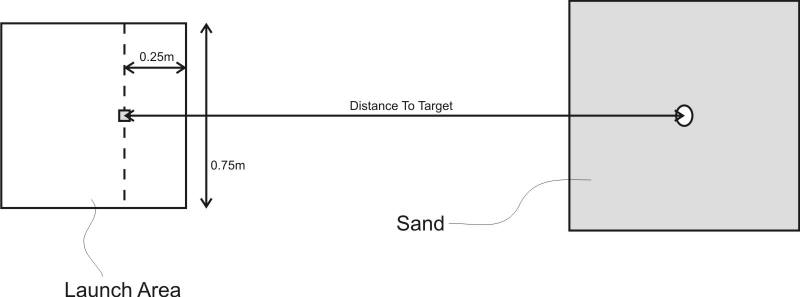 Class
14.5 Monday, 10/10/16
Class
14.5 Monday, 10/10/16 Warm-Up :
No warm-up today.
Today:
- Turn in your launcher practice problem solutions by the end of class today. If you completed them as a group, include the names of all group members.
- Projectile flight path portion of your spreadsheet is due today.
- Here are the current launcher groups. If you're not on the spreadsheet, someone from your group needs to fill out the launcher groups form.
- No sand-box until Tuesday.
- Projectile launcher work time.
- When you're shooting, be polite and safe. Don't disrupt the rest of the school. Stay away from classrooms. Don't break things or give the appearance that you're breaking things. Remember that inappropriate behavior from just a few students could prevent us from being able to do interesting projects in the future.
- Return all items to their proper locations and clean up any messes that you make. E.g. don't leave stools in the hallway and rubber bands on the counters.
- Competition Schedule and Details:
- Location: Guidance lobby
- 10 Minute Setup Time:
- launcher set-up and testing
- laptop pwer up and log-in
- Problems are handed out. Answer on paper. No
test-firing after this point. Test firing will result in
disqualification.
- The "launch area" will be either a 0.75m x 0.75m section of the floor or a 0.75m x 0.75m wooden table top. Your launcher must remain within this area, and the projectile must be launched from a point no higher than 0.5m above the surface of the launch area.
- The "distance to the target" will be measured horizontally from the center of the target to a clearly-marked central point 0.25m behind the front edge of the launch area.
- The target will be an egg in the center of a 1m square of sand.
- 20 minutes planning time
- Firing order is revealed.
-
Firing:
- Each group gets a total of 5 minutes to set up and fire at least once (twice at most) from each location.
- If two shots are fired from one location, the errors for those shots will be averaged.
- Error is determined based on the projectile's first point of impact. Bounces do not count.
- If you crack or dent the egg, your error for that shot is -5cm. If your projectile bounces off of the egg, your error is 0cm.
- Overall average low score wins
Online Textbook (OpenStax) Reading:
- Ch 4: Newton's Laws Intro
- Ch 4.1: Force
- Ch 4.2: Newton's 1st Law, Inertia
- Ch 4.3: Newton's 2nd Law, Concept of a System
- Ch 4.4: Newton's 3rd Law, Symmetry in Forces
Homework:
- Complete all three sheets within your projectile launcher spreadsheet and share it with Mr. Stapleton. Due on Tuesday. This assignment may be completed as a group.
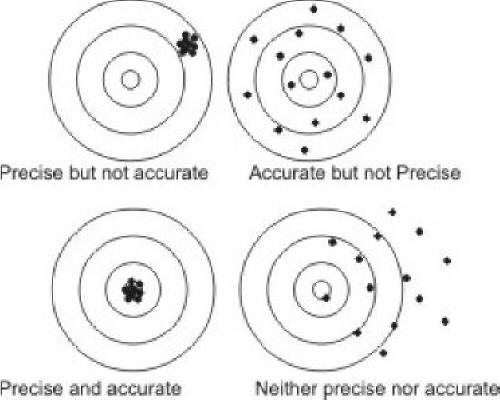 Class
14 Friday, 10/7/16
Class
14 Friday, 10/7/16 Warm-Up :
1. How can you measure the angle of your projectile launcher?
2. Based on the diagram to the right, what do the words accuracy and precision mean?
3. How can you maximize your projectile-launching accuracy? What about your precision?
Today:
- Fill out the launcher groups form.
- No sand-box until Tuesday.
-
Projectile launcher work time.
- When you're shooting, be polite and safe. Don't disrupt the rest of the school. Stay away from classrooms. Don't break things or give the appearance that you're breaking things. Remember that inappropriate behavior from just a few students could prevent us from being able to do interesting projects in the future.
- Experiment with ways to improve precision and accuracy.
- Calibrate your launcher (graph of initial velocity vs launcher setting).
- Finish your flight path spreadsheet.
- Practice shooting things. Suggestion -- input some angle and initial velocity into your trajectory graph. Attempt to shoot with those same values for angle and Vo. Compare your actual flight path to the spreadsheet. *** Don't forget to account for the release point of your launcher being higher than the surface on which the launcher rests.
- Return all items to their proper locations and clean up any messes that you make. E.g. don't leave stools in the halway and rubber bands on the counters.
- Projectile launcher competition on Tuesday. 2 Physics classes, 1 grand prize -- Large Pepperoni Pizza or Equivalent
Online Textbook (OpenStax) Reading:
Homework: Both assignments may be completed as a group
- Share with Mr. Stapleton by the end of class on Monday: Complete the trajectory (flight path) sheet within your overall projectile launcher spreadsheet.
- Due on Monday: Use your trajectory (flight path) sheet to "solve" the three example problems in the projectile launcher project overview. The solution to each problem must include an initial speed and a release angle. Together your speed and release angle combination should guarantee an impact point within 5cm of the target. For this homework, assume that the release point is at the same elevation as the "launch pad."
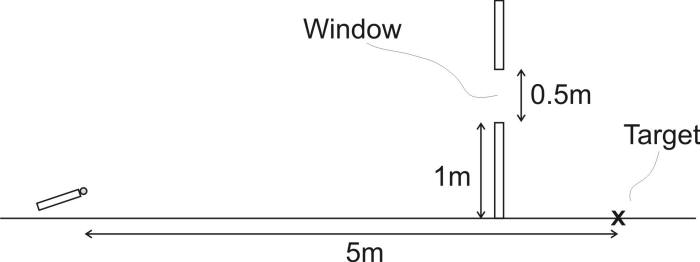 Class
13.5 Thursday, 10/6/16
Class
13.5 Thursday, 10/6/16 Warm-Up :
At the angle shown, can the projectile launcher hit the target? If not, how should the launcher be adjusted?
Today:
- Return Tests (grade distribution)
- Projectile launcher project overview
- Projectile launcher competition is going to be next week, not this Friday.
Online Textbook (OpenStax) Reading:
Homework:
- Complete before Monday, but do nut turn in until Tuesday: Complete the trajectory (flight path) sheet within your overall projectile launcher spreadsheet.
- Due on Monday: Use your trajectory (flight path) sheet to "solve" the three example problems in the projectile launcher project overview. The solution to each problem must include an initial speed and a release angle. Together your speed and release angle combination should guarantee an impact point within 5cm of the target. For this homework, assume that the release point is at the same elevation as the "launch pad."
Warm-Up : No warm-up today. Some students are leaving early, so we will start the test right away.
Today:
- Test
- Projectile Launcher Clarification
- Projectile launcher competition is going to be next week, not this Friday.
Online Textbook (OpenStax) Reading:
Homework:
- Read the overview of the projectile launcher project (with a few changes).
- Watch this video showing you the type of spreadsheet that your group must create, and how to use it.
- If you want to spend more time shooting and less time creating spreadsheets in class, begin creating your spreadsheet (see project overview for details).
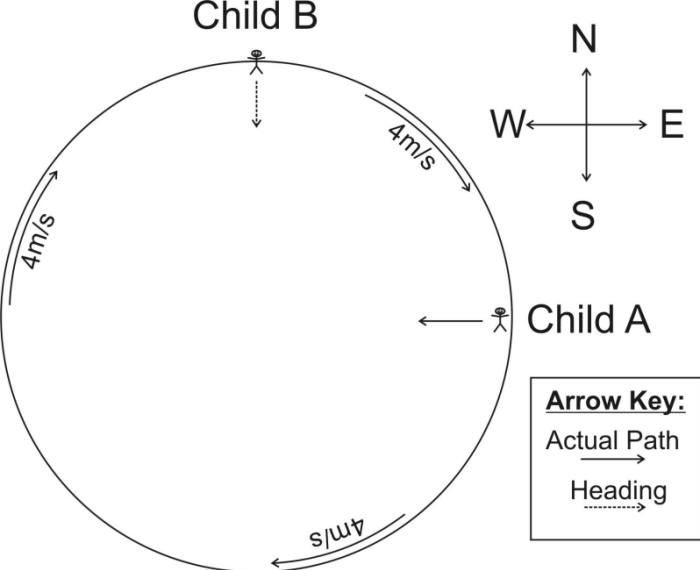 Class
12.5 Tuesday, 10/4/16
Class
12.5 Tuesday, 10/4/16 Warm Up :
Some children are standing on a very, very, large merry-go-round that is rotating clockwise when viewed from above.
1) Child A is standing near the eastern edge of the merry-go-round. The velocity of the merry-go-round at that point is 4m/s southward. The child always walks at a rate of 5m/s across any surface. What compass heading should the child follow if child A wants to actually travel in a Westward direction? What will be the child's ground speed?
2) Child B is standing near the northern edge of the merry-go-round, so the velocity of the merry-go-round near Child B has a velocity of 4m/s eastward. This child is slightly slower, always walking at a rate of 3m/s across any surface. If the child walks with a heading that is directly southward, what will be Child B's actual direction and speed of travel, relative to the Earth?
Today:
- Test Review? Ch 3 Test next Wednesday (2-D kinematics)
- Projectile Launcher Clarification
Online Textbook (OpenStax) Reading:
-
3.1 Kinematics Introduction -- Pythagorean Theorem and Displacement
-
3.3 -- Vector Addition and Subtraction -- Analytical methods
Homework:
- Study. Test tomorrow. You will be given all of the formulas from the first test, plus the formulas on the recent practice test.
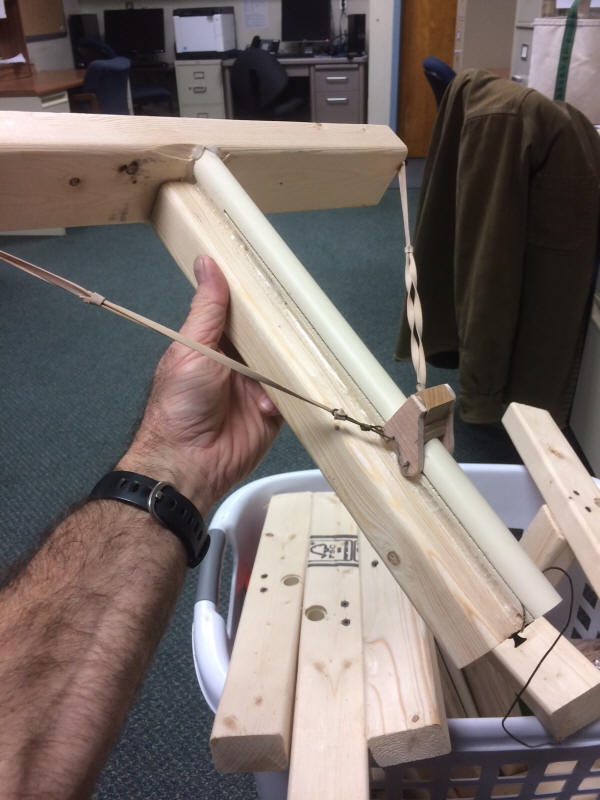 Class
12 Monday, 10/3/16
Class
12 Monday, 10/3/16 Warm Up :
How can you find the muzzle velocity of a projectile launcher?
1) Propose at least two different methods of finding the projectile's initial speed.
2) Which method is easiest? Why?
3) Do you know of an easy way to tie a loop on the end of a piece of string?
Today:
- Test related questions? Ch 3 Test next Wednesday (2-D kinematics)
- Introduction to projectile launchers and project
- Spreadsheets-- see YouTube Video for explanation
regarding completion of spreadsheets.
- Spreadsheet for determining initial speed -- Use this copy of Mr. Stapleton's Sheet
- Spreadsheets-- see YouTube Video for explanation
regarding completion of spreadsheets.
- Trajectory (Flight Path) spreadsheet -- Use this template to create your own.
- Launcher Initial Speed Calibration -- Use this template to create your own.
- Projectile Launcher Project Outline
- Monday
- Form groups of 3 (possibly 2)
- Familiarize with launchers. You will be sharing the
basic launcher with a group from the other class.
- Share: basic launcher frame and trigger
- Don't share: pluncher, string, rubber bands
- Work on spreadsheets
- Tuesday: Calibrate launcher, complete spreadsheets
- Wednesday: Test. Launcher time after test.
- Thursday: Launcher work time
- Friday:
- Competition
- Be prepared for any release angle between 0 and 70 degrees and any initial speed between 3m/s and 9m/s.
- Launch surface may be higher or lower than target height.
- Launch through a window at some vertical height between launcher and target (e.g. window spans 1.5m to 2.5m, vertically, and is 2m, horizontally, from the target. Launch platform is 5m, horizontally, from the target)
- Logistics:
- Final calibration time
- Problems are presented
- Calculation time
- One shot at each target.
- What to turn in:
- Share your completed spreadsheets.
- Problem sheet with solutions and an explanation of how you arrived at those solutions.
- Grading based on satisfactory completion of spreadsheets and problem sheet (above.) Extra points added to winners' scores: 1st place = 5%. 2nd Place 3%. 3rd Place = 2%.
- Prize for overall winners.
- Competition
- Monday
Online Textbook (OpenStax) Reading:
-
3.1 Kinematics Introduction -- Pythagorean Theorem and Displacement
-
3.3 -- Vector Addition and Subtraction -- Analytical methods
Homework:
- Prepare for a Test on Wednesday. You will be given all of the formulas from the first test, plus the formulas on the recent practice test.
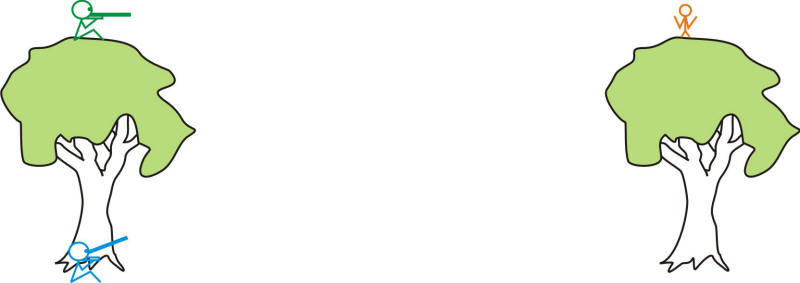 Class
11.5 Friday, 9/30/16
Class
11.5 Friday, 9/30/16 (B7: 12:25-12:55, B8: 1-1:30)
Warm Up : A green hunter and a blue hunter point their guns directly at a fake orange monkey and then fire simultaneously. Just as the two hunters fire their guns, the monkey slips and freefalls from the treetop.
1. Where does each hunter's projectile end up, relative to the monkey? High, low, or in the monkey?
2. How would the result have been different if the monkey stayed in position at the top of the tree?
3. Do the answers to these questions depend on the bullet velocities?
Today:
- Check/discuss 2-D Kinematics Practice Test -- Answers/Solutions
- Ch 3 Test next Wednesday (2-D kinematics)
Online Textbook (OpenStax) Reading:
-
3.1 Kinematics Introduction -- Pythagorean Theorem and Displacement
-
3.3 -- Vector Addition and Subtraction -- Analytical methods
Homework:
- Prepare for a Test on Wednesday. You will be given all of the formulas from the first test, plus the formulas on the recent practice test.
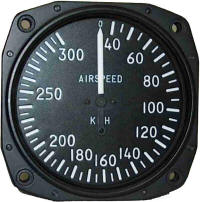
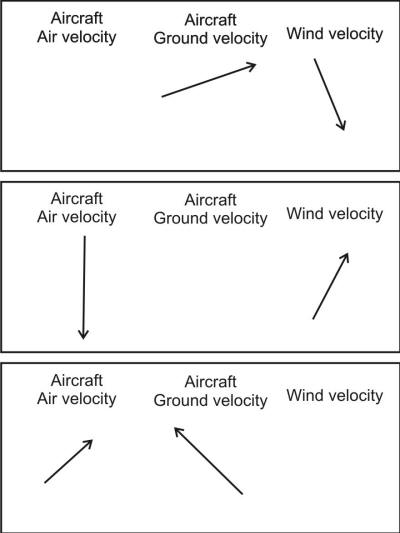 Class
11 Thursday, 9/29/16
Class
11 Thursday, 9/29/16Warm Up :
Aircraft pilots use the terms "air speed," "ground speed," and "wind speed."
1. What does each of the terms mean?
2. In vector addition problems, which of those quantities will always be the magnitude of the resultant vector?
3. In the figures on the right, why was the word "velocity" substituted for "speed?"
4. For each of the figures on the right, visualize the missing vector.
5. Two canoeists travel across a lake. Both want to head directly toward magnetic North, but there is a wind blowing westward. The first canoeist pulls out a compass and begins to paddle so that the bow of the canoe is always in line with the north-pointing compass needle. The second canoeist uses the compass to find a tree that is directly to the north on the other side of the lake. The second canoeist then paddles with the bow of the canoe always pointing toward the tree. Do the paths of the canoeists differ? If so, how?
Today:
- Review Currents and Projectiles -- Notes and Practice #1 and #2. (solutions)
- 2-D Kinematics Practice Quiz -- solutions are on Misterstapleton YouTube channel.
- Ch 3 Test next Wednesday (2-D kinematics)
Online Textbook (OpenStax) Reading:
-
3.1 Kinematics Introduction -- Pythagorean Theorem and Displacement
-
3.3 -- Vector Addition and Subtraction -- Analytical methods
Homework:
2-D Kinematics Practice Quiz -- solutions are on Misterstapleton YouTube channel.
 Warm Up
:
Warm Up
:
In the absence of friction, if you made a hole through the center of the Earth, you would come out the other side in approximately 42 minutes.
1. What else would happen to you?
2. Where would you come out?
3. What if there were air resistance? (antipodes map)
Excel spreadsheet -- falling through the earth
Today:
- Check/review river problems (solutions 2-3) (solutions 4-5)
- Currents and Projectiles -- Notes and Practice (solutions)
Online Textbook (OpenStax) Reading:
-
3.1 Kinematics Introduction -- Pythagorean Theorem and Displacement
-
3.3 -- Vector Addition and Subtraction -- Analytical methods
Homework:
- No new homework
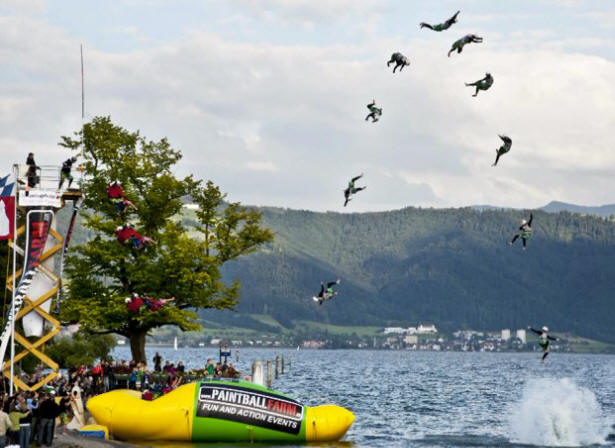 Class
10 Tuesday, 9/27/16
Class
10 Tuesday, 9/27/16Warm Up :
1. What is happening to Vx and Vy at each moment in this photograph?
2. If each of jumper's images represents a successive video frame, was the frame rate constant?
Today:
- Check/review river problems 1-2 (solutions)
- Currents and Projectiles -- Notes and Practice (solutions)
Online Textbook (OpenStax) Reading:
-
3.1 Kinematics Introduction -- Pythagorean Theorem and Displacement
-
3.3 -- Vector Addition and Subtraction -- Analytical methods
Homework:
- Projectile Practice Problems #1 and #2 from Currents and Projectiles -- Notes and Practice
- Finish "still more river problems"-- #s 4 and 5. Still More River Problems
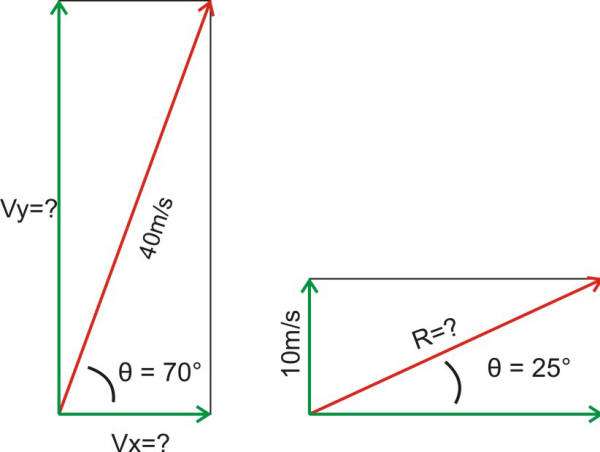
Warm Up : Trig. review
1. What are sine, cosine, and tangent?
2. Use trigonometry to find the missing vector magnitudes on the right.
Today:
- Check/review river problem [Solution -- On Jane's method, the math under the radical is incorrect. It should be (3m/s)2- (2m/s)2]
- Pumpkin Chuckin' Update.
- Using Trig to solve the "random" vector problems from last class. Here's a new answer sheet.
Online Textbook (OpenStax) Reading:
-
3.1 Kinematics Introduction -- Pythagorean Theorem and Displacement
-
3.2 -- Analytic methods...
Homework:
Warm Up :
1.
Suppose the two vectors on the right represent two forces acting on the
clam. In what direction will the clam accelerate? What will
be the magnitude of the net force accelerating the clam in that
direction?
2. The diagram on the right shows a top view of a train car that is moving at a rate of 2m/s. You are in the car. In which direction and how fast should you walk in order to have the intended velocity shown on the right.
Today:
- Vector Addition and More -- Mr. Chase's PowerPoint
- Graphical Vector Addition --Head to Tail Method
-
How to do it:
- Draw all vectors pointing in their proper directions and with lengths proportional to their magnitudes.
- Arrange all component vectors head to tail. The resultant vector connects the final head to the final tail, but the connection is head to head and tail to tail.
- Orthogonal Vectors (Solutions)
- Random Vectors (Solutions)
-
How to do it:
Online Textbook (OpenStax) Reading:
Homework:
- Finish orthogonal and random vector assignments (above)
- Classic River Problem
 Class
8.5 Thursday, 9/22/16
Class
8.5 Thursday, 9/22/16Warm Up : How can we use Logger Pro to calculate the flight displacement of the soccer ball in the video on the right? (ignoring the effects of air resistance).
Today:
- Return extended problems
- Grades are in PowerSchool
- Explain Grading -- tests, quizzes, other, quarter
- Check your grades
- Graphical Vector Addition -- Head to Tail Method
Online Textbook (OpenStax) Reading:
-
New Unit
Homework:
- Suggested -- reading, see above.
- If you want to do test corrections, show your new answers and your work on another sheet of paper. If I accidentally fixed your answer for you, explain the reason for the change in the answer. To get credit, meet with Mr. Stapleton to go over your corrections. Flex block is a good time. You may be expected to answer some questions about your corrections.
 Class
8 Wednesday, 9/21/16
Class
8 Wednesday, 9/21/16Warm Up : (Ignore air resistance for all questions)
Suppose a plane is flying at a constant elevation of 500m and the pilot is trying to drop a bomb on a target on the ground.
1. If the plane is flying with a speed (relative to the ground) of 200m/s, how far in advance should be bomb be released?
2. For an observer watching the plane from our perspective, what is the shape of the bomb's flight path?
3. How does the bomb's flight path appear different to someone on the plane?
4. If a base jumper had jumped off of a 500m tall tower just as the plane passed and dropped the bomb, how would the bomb's flight path appear to the jumper.
Today:
- Return tests
- Extended problem.
- Graphical Vector Addition -- Head to Tail Method
Online Textbook (OpenStax) Reading:
-
New Unit
Homework:
- Suggested -- reading, see above.
- If you want to do test corrections, show your new answers and your work on another sheet of paper. If I accidentally fixed your answer for you, explain the reason for the change in the answer. To get credit, meet with Mr. Stapleton to go over your corrections. Flex block is a good time. You may be expected to answer some questions about your corrections.
Warm Up : None
Today:
- Test
Online Textbook (OpenStax) Reading:
-
New Unit
Homework: Optional -- reading, see above.
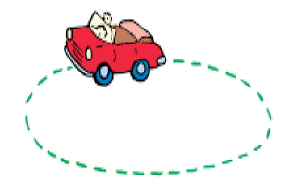 Class 7 Monday, 9/19/16
Class 7 Monday, 9/19/16Warm Up :
A race car is traveling counterclockwise around a circular track. The car's speedometer stays on exactly 100mph the whole time.
1. Describe each of the following: a) the car's speed b) the car's velocity c) the car's acceleration.
 2. An
object can have increasing speed and decreasing velocity at the same
time. Which other combinations of speed and velocity are possible?
2. An
object can have increasing speed and decreasing velocity at the same
time. Which other combinations of speed and velocity are possible?
Today:
- Check/Discuss homework -- questions?
- Questions about the test?
- Test Topics
- Concepts: vectors and scalars, position, speed, velocity, acceleration, displacement, distance traveled
- Relationship between acceleration, speed, and velocity. Be able to provide real examples of objects having different combinations of a, v, and speed.
- Solving Problems with Kinematics Formulas:
- You will be expected to memorize the simplest formulas. The diagrams on the right show the formula list that I have been giving you and the trimmed down version that will be provided on the test. Memorize the formulas that have been crossed out. *You may want to add them to the list as soon as you receive your test.
- Draw a picture
-
 List
what you know: vx0, v, vave, Δv,
x, x0, Δx, t, t0, Δt,
aave = a
List
what you know: vx0, v, vave, Δv,
x, x0, Δx, t, t0, Δt,
aave = a - Find the right formula (know ahead of time what each can do)
- Don't forget to include proper units with your answer.
- In the case of freefall, a = g.
- Memorize g (average acceleration due to gravity at Earth's surface). g = -9.8m/s2
- Graphical representation of position, velocity, and
acceleration
- Velocity = slope of position vs. time graph
- Acceleration = slope of velocity vs. time graph
- Freefall -- what does it mean?
- What to study: everything -- notes, practice problems/question, the quiz
- New Unit: 2-D motion
Online Textbook (OpenStax) Reading:
-
All of Chapter 2
-
New Unit
Homework: Study for the test. There will be no warm-up next class; just the test. Bring a pencil and a calculator.
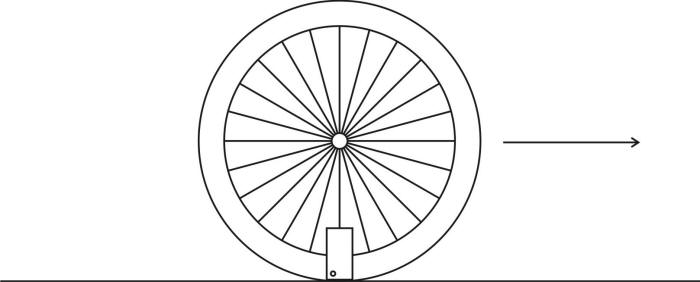
 Class
6.5 Friday, 9/16/16
Class
6.5 Friday, 9/16/16Warm Up :
Suppose we strap a light source to a bike tire and then roll the tire to the right while taking a long-exposure photograph through several rotations of the tire.
1. Describe the appearance of the photograph.
2. In the X dimension, what would graphs of position, velocity, and acceleration look like for the light source?
Today:
Online Textbook (OpenStax) Reading:
-
Chapter 2.7: Falling Objects (Freefall)
Homework:
- Complete Kinematics Review and Loose Ends and check your answers using Kinematics Review and Loose Ends -- Answers. Come to class prepared to ask questions about problems you may have encountered on the assignment.
- Open your kinematics spreadsheet and check for "wrong" answers. See if you can figure out what is wrong about them.
Warm Up :
A car is traveling in a positive direction down a straight road with multiple traffic lights. At t0, the car is sitting still at a light. After a few seconds, the light turns green and the car travels to the next traffic light, at which it stops. The car waits until the light turns green, and then it travels to the next traffic light and stops again at tfinal.
1. Sketch a reasonable graph of position vs time for the car's journey.
2. Use your position vs. time graph to sketch a graph of velocity vs. time.
3. Use your velocity vs. time graph to sketch a graph of acceleration vs. time.
Today:
- Review spreadsheet assignment
- Check/discuss homework problems
- Tying up loose ends before the Test.
Online Textbook (OpenStax) Reading:
-
Chapter 2.7: Falling Objects (Freefall)
Homework:
Before Monday: Complete Kinematics Review and Loose Ends and check your answers using Kinematics Review and Lose Ends -- Answers. Come to class prepared to ask questions about problems you may have encountered on the assignment.
Warm Up :
No warm-up today.
Today:
- Work in the computer lab:
- finish the spreadsheet.
- When your spreadsheet is complete, share your document with Mr. Stapleton.
Online Textbook (OpenStax) Reading:
Homework: Extended kinematics problems
 Class
5 Tuesday, 9/13/16
Class
5 Tuesday, 9/13/16Warm Up :
A lead ball is free-falling downward. At a height of 100m, the ball's velocity is -10m/s. Use the formula above to find the ball's height when it reaches -20m/s?
Assume a = g = -10m/s^2.
Today:
- Check/discuss homework
- Look at some motion videos
- Freefall notes
- Intro to working with formulas in spreadsheets.
- Work in the computer lab:
- Make a copy of the Kinematics Formula Spreadsheet Template. Rename it with your name. Solve all of the problems by inserting formulas into the yellow cells.
- Tomorrow, go directly to the computer lab. You will have the whole class to finish the spreadsheet.
- When your spreadsheet is complete, share your document with Mr. Stapleton.
Online Textbook (OpenStax) Reading:
Homework:
- Tomorrow's class will be entirely in the computer lab. Show up there.
- Finish the kinematics formula spreadsheet before class on Thursday. You will have all of next class to work on it in the computer lab.
 Class
4.5 Monday, 9/12/16
Class
4.5 Monday, 9/12/16Warm Up :
10 letter symbols are used in the formulas on the right. Be prepared to explain the meaning of each symbol and how to find a value for that symbol.
Today:
- Return/discuss quiz.
- Freefall notes
Online Textbook (OpenStax) Reading:
Homework:
- Find a way to measure/calculate/estimate the acceleration of gravity using this video. If you started early, and you used Logger Pro, that's okay, but otherwise find a solution that does not involve logger pro. With a little ingenuity, you can arrive at a decent answer from any computer with internet access. Remember that you can see greater detail if you download the video and watch it using Quicktime. Show your work and be prepared to show/explain your methods to the class. If you cannot find a way to do this, explain why you can't. What data are you missing, and how would you get it? There are more precise and less precise ways to do this, but you will not be graded on the precision of your answer. You already know what it should be. Due Tomorrow.
- Optional -- If you need more practice using kinematics formulas, work through the examples and practice problems in the online textbook, Chapter 2.5: Motion Equations for Constant Acceleration in One Dimension
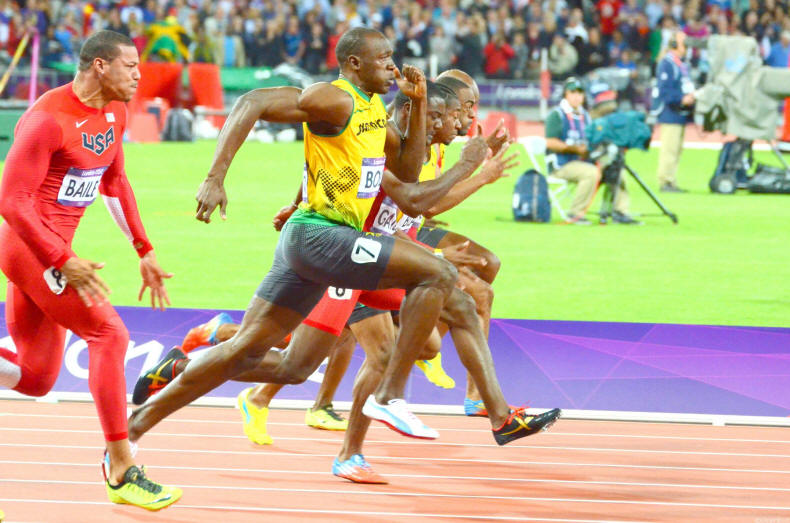 Class
4 Friday, 9/9/16
Class
4 Friday, 9/9/16Warm Up :
1. How many feet are in a mile?
2. Usain Bolt sprinted 100m in 9.58s. If 1 foot = 0.3048m, what was his average speed in miles per hour? Please do not look up the unit conversion on the web!
Today:
- Quiz
- Freefall notes
- Make and shoot paper projectiles. Then estimate their apogees and initial velocities.
Online Textbook (OpenStax) Reading:
Homework:
- Find a way to measure/calculate the acceleration of gravity using this video. Show your work and be prepared to show/explain your methods to the class. Due on Tuesday.
- If you have not finished the video analysis activity, but you would like to receive credit for it, you must have your spreadsheet row filled out by Monday.
Warm Up :
Match each position vs. time graph with the correct velocity and acceleration graph.
Today:
- Check/review homework (solutions -- pdf)
- quiz preview
- Look at some motion videos -- prizes for fastest/most acceleration
Online Textbook (OpenStax) Reading:
Homework: Practice quiz next class. If you like your score, you can keep it as a real quiz grade. What's on the quiz:
- Velocity notes
- Notes: Acceleration and kinematics formulas -- formulas will be provided on the quiz. Solutions will be straightforward (unlike #9 and #10 on last night's homework). To solve each problem, you will be able to find an equation with one missing variable.
- You must provide answers with correct units.
- Interpreting position vs time and velocity vs time graphs. The motion sensor activity should have helped prepare you for this. Expect questions like the warm-up from today and from class 1.5.
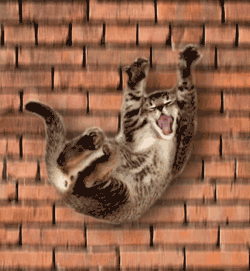 Class
3 Wednesday, 9/7/16
Class
3 Wednesday, 9/7/16Warm Up :
Emergency clinic records of 132 cats that jumped from windows of buildings showed a 90% survival rate. The average drop was 5.5 floors.
1. Why do injuries increase from floors 1-6? Why would injuries decrease at over 7 floors?
2. When you're solving physics problems, what do you think matters most, using the correct units or using the correct symbols?
Today:
- Notes: Intro to Kinematics Formulas
- Library computer lab work time -- 12:00 for A5/6, 1:50 for A7/8.
Online Textbook (OpenStax) Reading:
Homework: Kinematics problems 1-10 Answers Below:
1. 4 yards/sec 2. 3.33 hours 3. -78.4m/s 4. -490m 5. -0.4m/s^2 8a. 3m/s^2 8b. -37.5m 9. -4.4m/s^2 10. 13.33m/s
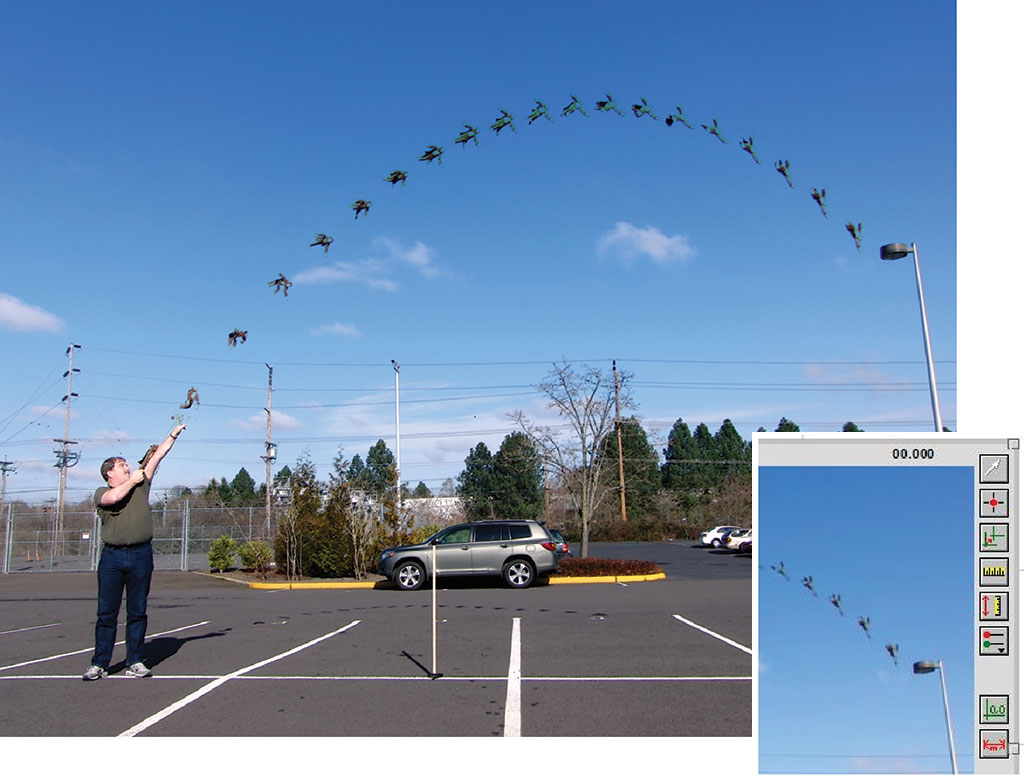 Warm Up
:
Warm Up
:
Assuming that the man in the picture is 2m tall, and the frame rate of the camera was 10fps, what were the approximate maximum and minimum speeds of the object?
Today:
- Share/upload video footage
- Complete Logger Pro Analysis of a video.
- How to create position vs time and velocity vs time graphs.
- Begin Video Analysis:
- Choose two videos. Make sure that each video is accessible (shared -- "anyone with link) through someone's Google Drive.
- Download both videos and use frame-by-frame analysis to create position vs time and velocity vs time graphs for each video.
- Try to analyze one video using Logger Pro and analyze another video without using Logger Pro. To use Logger Pro, you will probably need a school computer. To make your task easier, feel free to copy these spreadsheets (Logger Pro method for stationary camera, Moving Camera Method) and modify them to meet your needs. If you need help, watch Mr. Stapleton's video on the misterstapleton YouTube channel. Hopefully, instructions will be uploaded by Tuesday after school.
- Paste links to your videos and completed graphs here -- A5/6, A7/8
Online Textbook (OpenStax) Reading:
Homework: None. Continue video analysis next class.
 Class 2
Friday, 9/2/16
Class 2
Friday, 9/2/16Warm Up :
A runner sprints exactly 100m, rests for a moment and then slowly follows the same path back to the starting line. This entire trip takes 200s. For the questions below, consider the runner's entire round trip.1. What distance did the runner travel?
 2. What was the runner's displacement?
2. What was the runner's displacement?3. What was the runner's average velocity?
4. What was the runner's average speed?
5. Why is the thirsty man so small?
more Julian Beever pictures (like the one on the right)
Today:
- More course expectation signatures?
- Check homework
- Motion Video Scavenger Hunt
Links:
Example Logger Pro Analysis -- partly done
moving camera spreadsheet link
Online Textbook (OpenStax) Reading:
Homework:
- Suggested reading: Chapter 2.3: Time, Velocity, and Speed. You may want to preview 2.4 (acceleration).
.JPG)
- moving at a constant speed
- moving toward the sensor)
- not moving at all
- accelerating
- decelerating
- accelerating the fastest
- moving at the fastest constant speed
Today:
- Turn in course expectations
- Velocity notes Velocity notes Answer Key
- Online metronome
Handouts:
Online Textbook (OpenStax) Reading:
Homework:
- Complete velocity notes #5-8
Wednesday, 8/31/16
Physics 200: Mr. Stapleton
Warm Up Question:
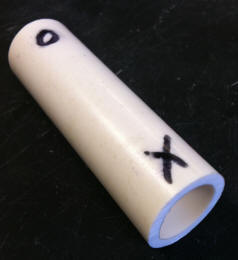 Spin
one of the "sprotating cylinders" by pressing one end until it squirts
out from under your finger. Try pressing the other end.
Spin
one of the "sprotating cylinders" by pressing one end until it squirts
out from under your finger. Try pressing the other end.
When the cylinder is spinning, why do you only see the symbol that you press?
Today:
- Learn names/pronunciations
- Enter attendance
- Mr. Stapleton background, philosophy, slideshow, etc.
- Go over course expectations, class overview
- First Quarter (subject to change):
- Approximately 3 tests
- 1 major project
- First Unit: Motion in 1 Dimension. Velocity, acceleration, etc.
- First Quarter (subject to change):
- Questions?
- Motion Matching Activity Matching Motion Graphs with motion detector(Web page)
Handouts:
Online Textbook (OpenStax) Reading:
Homework:
- Have your parents/guardians review and sign your course expectations. Then return them to Mr. Stapleton.
- Suggested Reading (see above)
- Other?



